Forum - View topicErrinundra's Beautiful Fighting Girl #133: Taiman Blues: Ladies' Chapter - Mayumi
|
Goto page Previous Next |
| Author | Message | |||
|---|---|---|---|---|
|
Zin5ki
Posts: 6680 Location: London, UK |
|
|||
The slice-of-life elements never quite dovetailed with the film's sobering core, I found. The early scenes wherein Suzu relocates and marries are not tedious or unnecessary, though to a certain extent they were disjointed. One can tell the source material was of a serial format rather than being a single volume narrative. Of course, by the time the film finally becomes focused and coherent, the characters are in as dire a situation as one could imagine. Anyone would be forgiven for preferring the clumsy but careless first act to the horrific weight that the story ultimately carries. |
||||
|
||||
|
Errinundra
Moderator
Posts: 6580 Location: Melbourne, Oz |
|
|||
|
Beautiful Fighting Girls index
**** Splash(es) of Crimson #8: Maria Grace Fleed & Hikaru Makiba 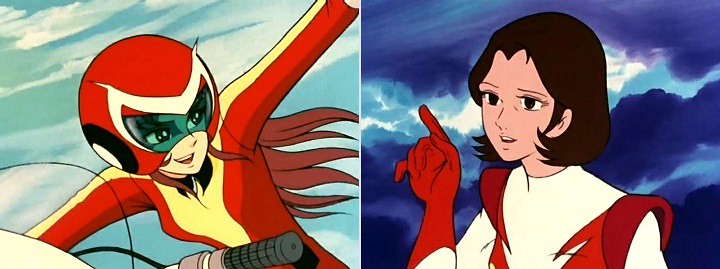
UFO Robo Grendizer Synopsis: Vegans are rampaging across the galaxy, spreading their evil social justice values thanks to the overwhelming superiority of their vegatronic energy. The planets they don't enslave, they reduce to unpalatable wastelands. Duke Fleed is a young refugee from one such devastated world, fleeing to earth with his powerful giant robot come spaceship, Grendizer. Once on earth he becomes the adopted son of Doctor Genzo Umon, who researches cosmic energy sources at his Space Science Laboratory outside of Tokyo. When Duke Fleed (aka Daisuke Umon) isn't fighting Vegans, he works on a neighbouring ranch run by Danbei Makiba, his daughter Hikaru and young son Goro. The Vegans, with the vegatronic energy almost exhausted and their home planet in terminal decay, launch an invasion of earth from the dark side of the moon, but they must first neutralise Grendizer. Duke Fleed is soon joined by Koji Kabuto - former pilot of Mazinger Z - fighting in his home-built flying saucer, while Doctor Umon designs and builds rocket powered fighter craft for their battles. In due course Hikaru is recruited to fly one of the "spazers" and, when Duke Fleed is re-united with his hitherto presumed dead sister Maria Grace, the team is complete. The four will fight the Vegans to the bitter end. Production details: Premiere: 05 October 1975 (between Beautiful Fighting Girl #18 The Star of the Seine and Beautiful Fighting Girl #19 The Wild Swans Studio: Toei, Dynamic Planning Chief director: Tomoharu Katsumata (see Mazinger Z) Source material: original production although manga adaptations ran simultaneously as Yufo Robo Gurendaiza in various magazines. Creator: Go Nagai Script: Go Nagai Music: Shunsuke Kikuchi Character Design: Kazuo Komatsubara, eps 1-48, & Shingo Araki (Cutie Honey, Hans Christian Andersen's The Little Mermaid, Galaxy Express 999, Lunlun the Flower Child, The Rose of Versailles, Mahou Shoujo Lalabel, Legend of the Galactic Heroes), eps 49-74 Comments: Go Nagai further refines and develops the giant robot formula he began with Mazinger Z and continued with Getter Robo in a package that is more entertaining than either. Compared with Getter Robo, Grendizer is more of a combining robot than a transforming one. That is to say, attaching one of the spazers to the giant robot, as piloted by Duke Fleed, gives him greater powers or more freedom of movement. For starters, Grendizer can't fly, so having a spazer nearby is crucial. Double Spazer (piloted by Koji) massively increases its firepower; Marine Spazer (Hikaru) allows it to fight freely underwater; and Drill Spacer (Maria) enables it to travel underground at mach 9 (!!!). Duke Fleed even has his own spazer capable of space travel. These are functional developments but the real improvements lie in the superior characters with their more interesting interactions, along with less reliance on Go Nagai's characteristic idiotic humour, and reducing the significance of the monsters. The latter, in the guise of "saucer beasts" still make their predictable weekly appearance but, thankfully, their battles are mostly cursory thereby allowing a greater emphasis on the cat and mouse stratagems played between the Vegans and the Grendizer team. 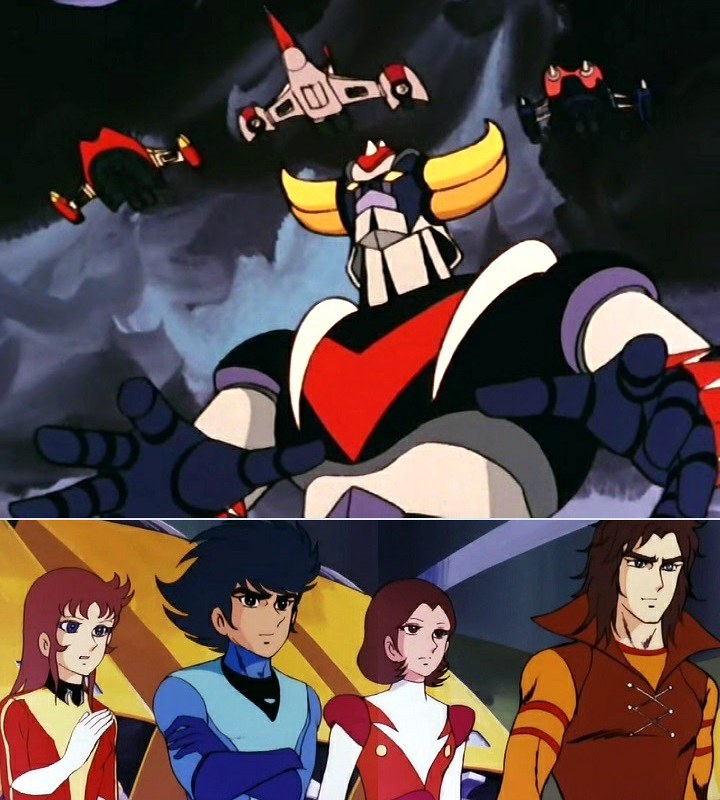
Top: Marine Spazer, Double Spazer and Drill Spazer overfly Grendizer. The team (l-r): Maria Grace Fleed, Koji Kabuto, Hikaru Makiba, Daisuke Umon (Duke Fleed) Daisuke Umon / Duke Fleed is at the heart of the narrative. Unlike Mazinger Z's Koji Kabuto he isn't a clown and unlike Getter Robo's serious Ryo Nagara he isn't dull. (Admittedly, I haven's seen Great Mazinger with a "rash" - to quote the ANN plot summary - Tetsuya Tsurugi as the protagonist.) I didn't warm to him: Fleed doesn't have a single humorous cell in his body, but that doesn't prevent him from anchoring the series. He has something of a late 60s / early 70s hippy aura about him, with his guitar playing, his peace and love idealism and rock star looks. Nevertheless, he embraces his warrior role and readily whacks any female who shows signs of hysteria. His success lies in the older brother sensibility he brings to the giant robot genre, thereby lifting the tone of the series, and in having his back story organically embedded in the central conflict. His maturity - slapping female characters aside - makes him a reliable lieutenant to Doctor Umon and creates a fruitful dynamic with the impetuous Koji. Initially Fleed and Koji are each suspicious of the other, leading to frequent fisticuffs, but Koji's natural ability and never-say-die attitude will eventually win Fleed over. Like an over eager puppy, Koji will, in time, respond positively to the stronger dog's approval. The villains are irredeemably bad, with some notable exceptions. Tetchy Great King Vega wants to rule the universe in the expected unsubtle way of such villains, though some depth is added towards the end of the series as his situation deteriorates, his desperation grows and grief strikes close to home. Leader of the invasion, General Gandal, other than one odd feature, is another by-the-book bad guy - simultaneously a bully and a coward who does the tiresome anime evil laugh as he contemplates victory and grinds his teeth and clenches his fists when that same victory slips from his grasp. His peculiarity is his dual nature. Within himself he has another, female character - Lady Gandal. In the first half of the series, Gandal's face occasionally opens up like a cuckoo clock and the miniature harpy pops out to express her, usually vicious, opinions. Once Shingo Araki takes over the character design role, her appearance is marked by a simple transformation from a male to a female face. When, near the end of the series, the alter egos find themselves irreconcilably divided, General Gandal's violent response is alarming, if effective. Blacki, a regularly appearing, subordinate villain in the first half, would be controversial in this day and age. His name alone would have people wringing their hands. In typical Go Nagai fashion female villains are either nightmares or attractive and conflicted. As always, the latter type are doomed from the moment they appear, inevitably and needlessly sacrificing themselves for the sake of the mostly undeserving male hero they had hitherto fought. The music swells as the hero stares meaningfully into the distant landscape. I roll my eyes. The bad guy I came to like was the science minister Zuril. He was the only Vegan mindful of what was going on, thereby generally coming up with the best stratagems. He was also the most restrained in his villainy and whose motivations stemmed from his character, not just the requirements of the plot or the eccentric imagination of Go Nagai. The almost self-deprecating set of his mouth and cast of his eye softened somewhat the brutality of his mission. 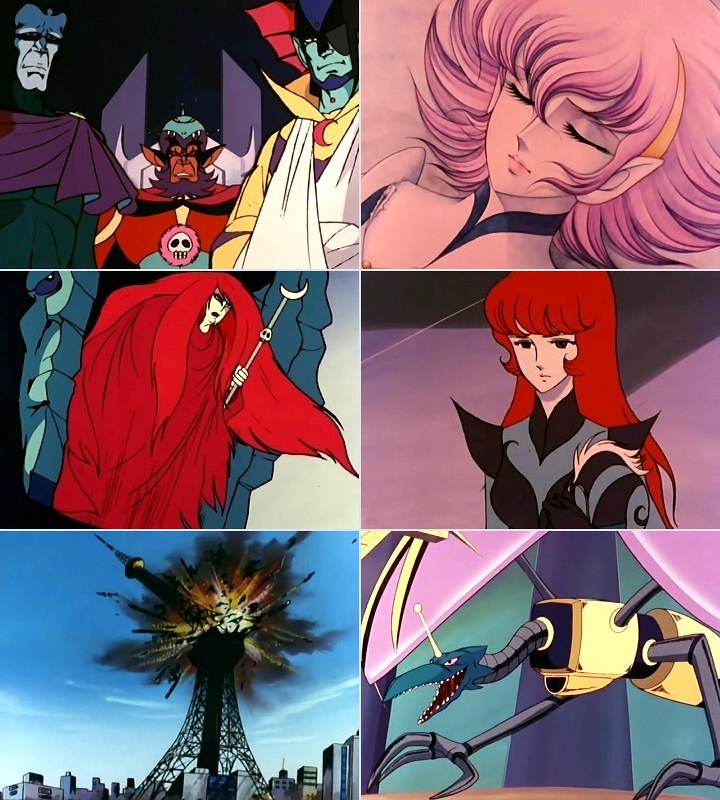
Clockwise from top left. The Vegan leaders - General Gandal, Great King Vega and Science Minister Zuril Kirika, a scientist sent to earth to kill Duke Fleed with her freezing ray. Princess Rubina, Great King Vega's daughter and one-time fiancée to Duke Fleed. (Shingo Araki's style is evident with Kirika and Rubina - think Lunlun and Oscar.) This saucer beast would be right at home in either Mazinger Z or Getter Robo Tokyo Tower cops it again. General Gandal's alter ego, Lady Gandal - she lives inside his face, here opened so she can talk. Splashes of crimson aside, other characters come straight from the Go Nagai inventory. Genzo Umon is a variation on Mazinger Z's Gennosuke Yumi, Danbei Makiba is a not so salacious reprise of Cutie Honey's Danbei Hayami, and Goro is the compulsory cheeky junior schoolboy who appears all the shows of his I've seen. Researching Go Nagai indicates that many of his stock character types go right back to earlier manga. I guess if a formula works, why change it? Character designs, until Shingo Araki comes along, are average to awful, sometimes intentionally so. Araki not only introduces new, more attractive characters, but he also ameliorates some of the awkwardness of the established players, especially the protagonists. It's an irony that the man who had such an impact on the look of shojo anime through Lunlun the Flower Child and The Rose of Versailles would establish his style in such diametrically different shows. Mechanical designs are variable. As only a minor tweak on Mazinger Z's robot design, Grendizer's aura is likewise strong and protective yet sinister. The spazers are effective if hardly groundbreaking, while the Vegan craft are, for the most part, ridiculous. Rather than flying saucers, think flying yoyos. In the case of the saucer beasts the two halves of the yoyo come apart to reveal an animal themed mecha that couldn't possibly have fitted into the space available. Duke Fleed usually despatches them in short time, but not before being racked with pain thanks to their vegatronic rays. Sado-masochism is another overused Go Nagai trope. No victory is achieved without gratuitous agony. A swimming pool episode and tight-fitting flying suits aside, fanservice is limited to Thunderbirds influenced elaborate launch routines and the obligatory combination and separation of Grendizer and the spazers. (I never understood why Duke Fleed was rotated through180º twice while being shunted between the spazer and Grendizer cockpits. Why bother? He ends up facing the same way.) Overall the background artwork and the animation further improve upon the earlier shows, without being particularly notable, other than the incongruous American / Mexican styled ranch and landscape scenery in what is otherwise rural Japan. The civilian characters even dress as cowboys or hombres. Go Nagai's predilection for garish palettes is somewhat muted but still evident. Militaristic or no, the music is a hoot, often being the most fun part of a battle or launch sequence. Less savoury is the valorising of violence and martial ideologies. With the uniforms, the routines, the hierarchical power structures and the embrace of violence, there's an element of fascism not only in Go Nagai's villains, but also in his heroes. Duke Fleed may play Flamenco guitar and wax lyrical about beauty, peace and justice, but he needs little provocation to thump Koji or slap the girls. He professes he'd rather not fight the Vegans yet he'll enthusiasticly indulge in regular mass slaughter of their ineffectual minifos (ie, mini ufos) and, later, the no more effective midifos. (One odd thing is how he, Koji, Hikaru and Maria have finely tuned good-guy radar. They have an unerring ability to pick which of their Vegan combatants have reservations about fighting.) Doctor Umon agonises over turning his research facility from peaceful to military pursuits. For all of two minutes. Thereafter he proudly presents his young charges with ever more destructive weapons. For sure, they are facing the end of the world as they know it, but warfare is presented as a lark, even for fourteen-year-olds. Admittedly, the overall tone makes this a more fun watch than the other shows, but it's precisely because of that element of fun that there's a disturbing undertow. The series was immensely popular with children in Italy (as Goldrake) and France (Golderak). In Italy it created a media fracas where Japanese shows were accused of "promoting fascism, anti-Communism, violence and an unwelcome degree of realism in depicting war" (Pelliteri via Clements) In France there was a similar backlash after it apparently achieved a 100% rating figure during school holidays, which, if true, make it the most watched anime ever by anyone. It became the subject of academic research and possibly the first ever book about anime published outside of Japan, Liliane Lurçat’s A cinq ans, seul avec Goldorak: Le jeune enfant et la télévision, looking at children's reactions to TV programs. 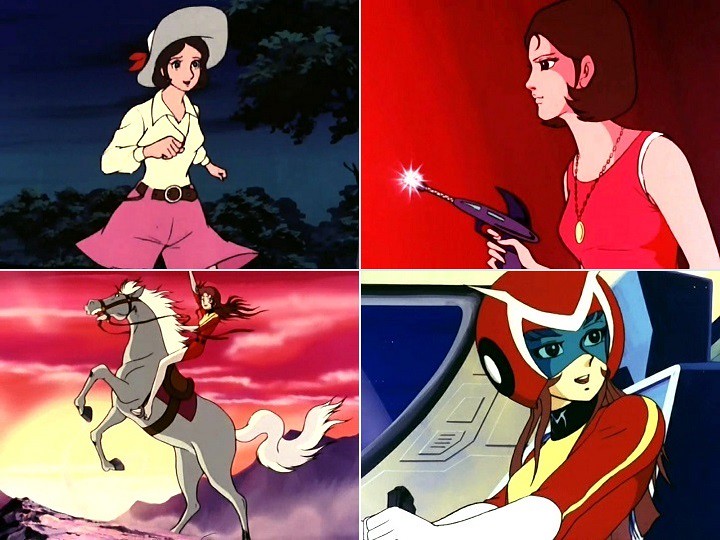
Cowgirls and crimson warriors: Hikaru (top) and Maria (bottom). Hikaru Makiba and Maria Grace Fleed: The greater appeal of UFO Robo Grendizer over the earlier franchises is partly due to the impact these two characters have on the show in general and upon the two male protagonists in particular. Hikaru is, literally, the girl next door, while Maria is the feisty interloper who stirs things up. For the first forty episodes Hikaru plays a subordinate role on her father's ranch. She's sweet on fellow farmhand Daisuke Umon, unaware that he's Duke Fleed, and is irritated when he constantly disappears inexplicably, sometimes in breach of undertakings. She doesn't know, of course, that he's off fighting the Vegans. (Hey, how can any self-respecting ranch hand not take up arms against Vegans. I mean, your livelihood is at Even though Hikaru and Maria prove themselves every bit as capable killers as their male counterparts and even though they are prototypes for future squadrons of beautiful fighting girls, their emancipation nonetheless has its limits. UFO Robo Grendizer is Duke Fleed's stage with Koji Kabuto his crazy offsider. In the second top image above, the two women are in their assigned place - a step behind the men. For the first forty episodes the treatment of Hikaru is patronising, something that lingers, though reduced, as she proves her mettle. This isn't her show, or Maria's. The near contemporary Star of the Seine, which wrapped up the same week Grendizer's episode 12 aired, showed the way forward. It demonstrated how the story of a regular young woman becoming a formidable fighter could make for compelling viewing. Simone is the owner of her narrative; Hikaru and Maria mere players in someone else's. 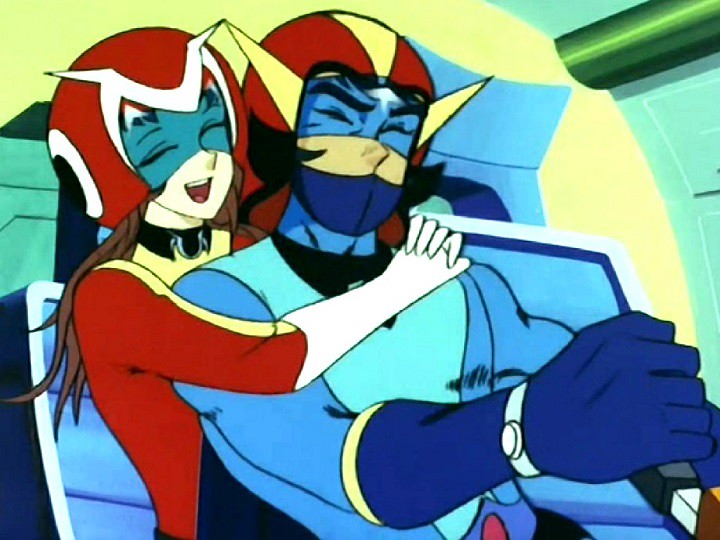
Genuine affection expressed physically: my favourite moment of the series. I'm a sentimental thing. Rating: So-so. Compared with the earlier Go Nagai giant robot shows UFO Robo Grendizer has better character dynamics and somewhat more sophisticated villains, while continuing his penchant for formulaic plots, dumb monsters, ugly graphics and a questionable take on violence. The whole thing is intended to be ridiculous, but ridicule isn't wit. Overall it was more fun than the older shows, hence the higher ranking. Resources: ANN Anime: A History, Jonathon Clements, Palgrave MacMillan via Kindle The Anime Encyclopaedia, Jonathon Clements and Helen McCarthy, Stone Bridge Press via Kindle The font of all knowledge Recommended reading The Mike Toole Show: Saint Shingo ** I've been vegetarian for almost thirty years, by the way. Last edited by Errinundra on Thu Jul 22, 2021 4:09 am; edited 1 time in total |
||||
|
||||
|
Errinundra
Moderator
Posts: 6580 Location: Melbourne, Oz |
|
|||
|
This is the first of four sequels and reboots I'll be looking at before getting back to reviewing originals. On an entirely unrelated matter I've managed to track down more episodes of Rainbow Sentai Robin so that I now have raw versions of all first eighteen episodes. Unless something noteworthy happens in the new episodes I won't update the original review.
A Splash of (very pale) Crimson #9: Yuki Mori 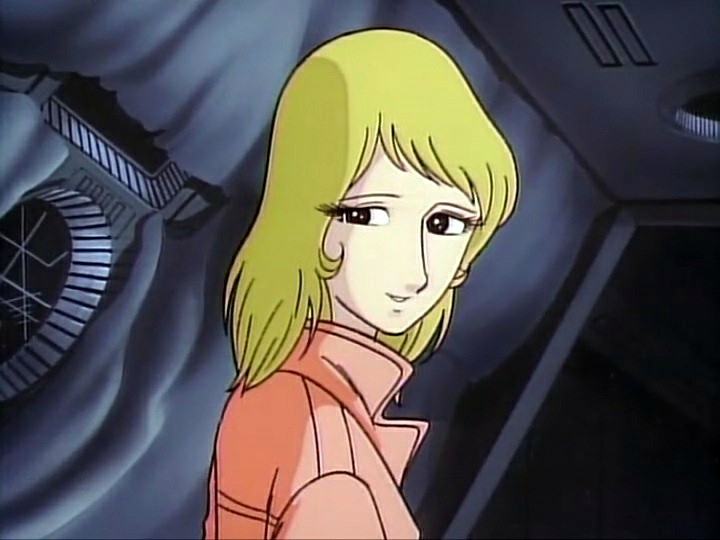
Farewell Space Battleship Yamato Synopsis: While escorting freight across the solar system former crew member of the space battleship Yamato, Kodai Susumu, receives a garbled radio message from the depths of space pleading for help. The message suggests that either the sender or earth are in dire trouble. Military authorities are unwilling to investigate the matter so Kodai enlists the help of the former Yamato crew in stealing the great ship, which is about to be scrapped. They set out for the distant planet Telezart where they free Teresa, an anti-matter being who projects her form as a beautiful human woman. She warns them that a gigantic, rotating interstellar comet is approaching earth. Hidden within its gaseous form is the White Comet Empire that enslaves or destroys every planet it encounters. In another race against time the Yamato must return to battle the empire. Production details: Premiere: 05 August 1978 (between Beautiful Fighting Girl #21 Majokko Tickle and Beautiful Fighting Girl #22 Galaxy Express 999) Studio: Group TAC, Office Academy, Toei Director: Toshio Masuda Concept story and general direction: Yoshinobu Nishizaki Screenplay: Keisuke Fujikawa, Toshio Masuda and Hideaki Yamamoto Production design and direction: Leiji Matsumoto Animation director: Tomoharu Katsumata and Shingo Araki among others. Original creator: Leiji Matsumoto and Yoshinobu Nishizaki Music: Hiroshi Miyagawa WARNING: SPOILERS. The very title of the film is a spoiler. In addition I will be discussing the deaths of some of the characters. Comments: With the movie adaptation of the original series outperforming Star Wars in some Japanese cinemas, the creators wasted no time in making this sequel, which follows the basic trajectory of the original: a return journey to a remote planet made under the threat of earth's annihilation in a legendary ship subject to relentless, deadly harassment. As with the Go Nagai formulae, why change something that works? Unlike the Go Nagai anime, though, the narrative is compelling, despite the 2½ hour run time, and even if the title gives away the ending and even if a Chekhov's Gun revealed half way through is clearly the solution to the underlying problem of how to defeat the White Comet Empire. Also inherited from the original series are a disregard for the laws of physics, implausible plot developments, another confounding resurrection, a seemingly sacred reverance for the great ship and a grandiose tone. 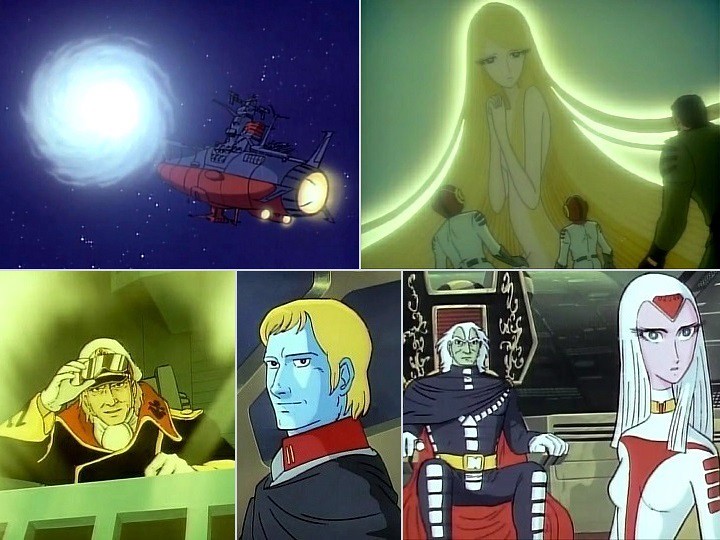
Clockwise from top left: Yamato approaches the Great White Comet; Teresa the anti-matter alien of Telezart - a very typical Matsumo character design; The Empress Sabera and Emperor Zwordar; Desslar makes an inexplicable return with a changed personality; and Yamato's Captain Ryu Hijikata is younger, clean-shaven version of Captain Okita. That tone is set from the start. Following a brief, narrated introduction, the Great White Comet appears, spinning with galaxy-like spiral arms and swallowing entire planets that lie in its path. The juggernaut's relentless progress is accompanied by magisterial yet profane church organ chords, as if God's throne in heaven has been usurped by Lucifer. I suggest turning up the volume for this unexpectedly drawn out and visually simple sequence to best experience the impact. For a brief moment, as the organ's first chords assault the listener, I am reminded of Gustav Holst's Mars, the Bringer of War from The Planets, an apt association for the sci-fi conflagration to come. The greater the threat, of course, the more glorious the heroism, the deeper earth's reliance upon and the brighter the aura of the Yamato. It's very name can momentarily reduce to silence the Emperor and Empress of the White Comet Empire (see image above). This is the spaceship, after all, that single-handedly destroyed the Gamilan Empire. By all accounts the franchise's premeditated myth-making was partly responsible for the subsequent cultural significance of the ship in the Japanese imagination. What other nation has fantasised that its greatest warship should become legendary across the galaxy? Don't forget, though, that the original ship was a military failure - sent on a suicidal mission without any possibility of strategic gain in a war for which it had no useful purpose. By redeeming the Yamato (which is a literary name for Japan itself) in a narrative where the ship's sacrifice isn't in vain, are the Japanese trying to redeem themselves? The problem is, the ship, as represented in the film, isn't able to engender the same sense of transendental stoicism so apparent in the original 26 episodes. It may simply be that 2½ hours simply isn't enough time for the ship to suffer sufficiently. Or, that, by the end of the film, the much less interesting Kodai Susumu has stolen the film's focus away from the ship. There's a bifurcation in the narrative that is hinted at in the film's Japanese title Saraba Uchū Senkan Yamato Ai no Senshitachi, which can be translated as Farewell to Space Battleship Yamato: Warriors of Love. On the one hand violence is the necessary solution to the problem the White Comet Empire presents. The movie, in the manner of the original series, portrays the violence in a gripping succession of set piece battles and individual heroism. On the other hand, love is idealised in the abstract (the common good, equality, self-sacrifice for others), the general (the earth, the human race, creation) and the particular (Kodai Susumu and Yuki Mori). The film is unable to reconcile the two poles. In one scene a character may espouse the most noble sentiments; in the next, slaughter their enemy in droves. For the love of earth Kodai will attempt to exterminate the entire White Comet civilisation. For the same reason the ghost of Captain Okita exhorts Kodai to use life itself as a weapon against the enemy, which seems to me a lot like justifying suicide bombers or WW2 special attack units. The split is possibly due to the differing creative approaches of Leiji Matsumoto and Yoshinobu Nishizaki. Matsumoto came to regret some of the creative decisions made, while Nishizaki was adament that to maintain the success of the first film it was, according to his 1977 proposal for the sequel, "necessary to aim for an unimaginably thrilling SF space action drama." He went on to summarise the development of Kodai's character as follows.
He then demolishes his own thesis by adding,
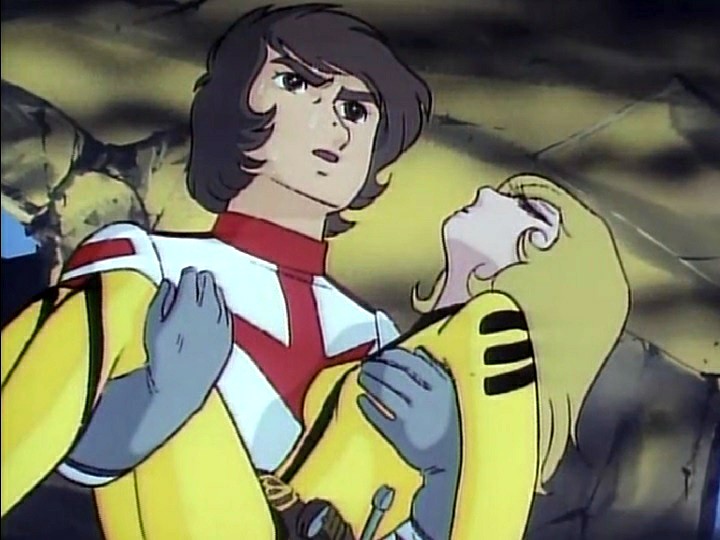
Kodai and the limp form of Yuki Mori. She's not dead yet. Without the scope that a 26 episode television series allows, the characters lack nuance. I'll come to Yuki Mori shortly, but most of the others rely on familiarity from the the earlier series. New characters such as Emperor Zwordar, Teresa the anti-matter woman, or space marine Hajime Saito, never extend beyond one dimension, but that's OK, as their roles are of secondary interest anyway. The Yamato's new captain is Hijikata Ryu (Kodai Susumu lacks the gravitas to pull off the role), a reworking of his predecessor, Jyuzo Okita, though a little younger and lacking the bushy beard. One intriguing return is Desslar (or Deslar or Desler, depending on the source), the Gamilan emperor sans empire, who has by now shown a penchant for dying in battle, then reappearing inexplicably shortly afterwards. So far he's been supposedly killed by the tectonic destruction of Gamilas, by a his own "Desslar" canon in the last episode of the television series, and now in a gunfight in Farewell Space Battleship Yamato. The last we see of him this time is his body floating away in the vacuum of space. I'm sure there's a loophole somewhere. Oddly enough his character has been re-jigged significantly. Where he was arrogant, supercilious and camp, now he's now simply proud. Where once he was dismissive of his enemies, now he admires them. He still treats his underlings as expendable, though. Character designs, with one exception, are prosaic at best. Teresa may have the most eccentric appearance, but, along with Starsha from the original series, will become a template for Matsumoto's feminine ideal that will reach clichéd levels in Galaxy Express 999, which began airing on TV about a month after Farewell Space Battleship Yamato premiered. Similarly the artwork and animation, while benefitting from a higher budget, are serviceable rather than inspired. Gold and yellow tones are frequently emphasised, giving the film a epic yet nostalgic glow. The music recycles the melodies from earlier but with much higher production values and more complex, mostly orchestral, arrangements. The organ theme mentioned earlier, introduced as a leitmotif for the White Comet Empire, adds mightily to the foreboding tone of the film. Yuki Mori: Compared with the original series, where she was largely a pin-up girl albeit highly capable, Yuki's is significantly diminished. Throughout the film she has a melancholy expression that presages her and most other characters' fate. At the outset she is preparing for her imminent marriage to Kodai, which is indicative of her situation thereafter. Secondary to Yodai, she is the embodiment of love, as both the object of Kodai's love and protection, and the expression of love through her devotion to him and her dedication to her duty as nurse to the Yamato's crew. Now pledged to Kodai her fanservice appeal is toned down for the most part - flaunting her body-hugging uniform isn't wifely behaviour, after all.. These traditional and restrictive roles prevent her from doing anything interesting other than throw herself in front of a laser beam to save Kodai's life. There begins the most bizarre element of the film. Structurally, her death is meant to be the catalyst to enable the male hero to make the transition, as per Nishizaki's proposal above, "to a great love for humanity". Instead, he lugs her body around for 30 minutes of the film's run time, finally declaring, as he sails toward oblivion cradling her cadaver, "Let us be married now, amongst the stars of this vast universe." She's dead, for goodness' sake! Rather than the intended profundity the sequence plays out as morbidly peculiar. Rating: Decent. A thrilling journey there and back to a remote planet, under the threat of imminent destruction, makes for a compelling 2½ hours of viewing. Other than improved production values there isn't anything particularly new or innovative compared with the original series, while some odd thematic elements undermine the story's appeal. Because I couldn't take the end seriously, it's rating is a couple of notches below the series. Resources: ANN 2201: Farewell to Space Battleship Yamato at the Voyager Entertainment Starblazers archived website. The font of all knowledge Anime: A History, Jonathon Clements, Palgrave MacMillan via Kindle Space Battleship Yamato Wiki Last edited by Errinundra on Thu Jul 22, 2021 4:09 am; edited 3 times in total |
||||
|
||||
|
Errinundra
Moderator
Posts: 6580 Location: Melbourne, Oz |
|
|||
|
Splash of Crimson #10: Fujiko Mine
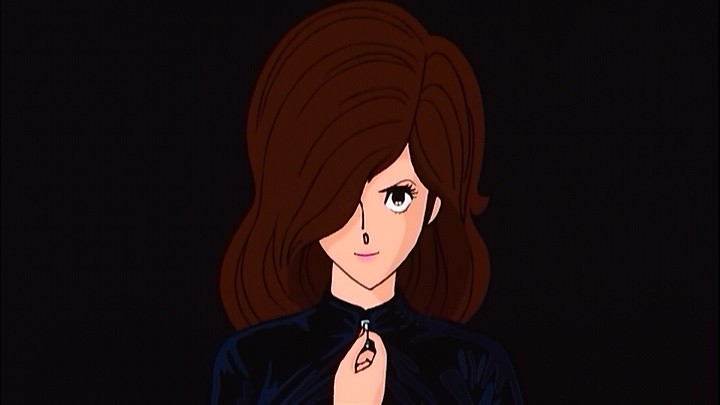
Lupin the 3rd: The Mystery of Mamo Synopsis: The real Lupin III has been hanged by the neck until dead, but the real Lupin III is also up to his normal antics as if nothing has happened. His latest caper is stealing the Philosopher's Stone from its hiding place in the Great Pyramid of Giza. Fujiko Mine has other thoughts about that. She's out to relieve him of the treasure on behalf of the mysterious Mamo who has promised her eternal life as a reward. Lupin will have to rely on his mutinous sidekicks, Jigen and Goemon, while the pesky Inspector Zenigata might just clap handcuffs on him if he isn't watching out. And just who was the real Lupin? Production details: Premiere: 16 December 1978 (between Beautiful Fighting Girl #22, Maetel, and Beautiful Fighting Girl #23, Anne Shirley) Directors: Soji Yoshikawa and Yasuo Otsuka Studio: Tokyo Movie Shinsha - this was their first full-length feature film Source material: Lupin III by Monkey Punch (Kazuhiko Kato) in Weekly Manga Action, 10 August 1967 to 22 May 1969 Original concept: Maurice Leblanc Screenplay: Atsushi Yamatoya, Jiku Omiya and Soji Yoshikawa Music: Yuji Ohno Character Design: Yuzo Aoki Art: Yukio Abe Animation Director: Yoshio Kabashima and Yuzo Aoki Note: there are four English dubs available on the Discotek release; this review is based on the Japanese dub with subtitles. Comments: After Takahata's and Miyazaki's bowdlerising of the original TV series, TMS - now sans the two famous directors for the film - returns to its roots with, by all accounts, a more faithful rendering of the Monkey Punch vision. Lupin even gets his red jacket back. The result is a racier tone, a more ambiguous relationship between Lupin and Fujiko, more angular character designs and a plot that's considerably more ambitious than was possible in an animated TV show of the time. While revamping those elements, the film adheres to the Takahata / Miyazaki decisions to ditch the hippy / psychedelic / noir sensibility of Osumi TV episodes while ramping up the slapstick humour and zany action. The combination of sexiness, violence and humour works very well for the most part, but the film does fall down in some important ways. I'm going to start with the problems, which aren't fatal to the film's success by any means, and work my way up to it strengths, one of which is Fujiko Mine, whom I'll consider last, in line with my previous splash of crimson reviews. 
What's a woman to do when the man who promises so much always falls short? The worst of the problems involve the big bad, Mamo, and the science fiction premise behind his 10,000 year lifespan. The film can be divided into three parts: Lupin's theft of the McGuffin (the Philosopher's Stone); the travails he suffers at the hands of various people as a result, including Fujiko Mine; which leads Lupin to her sponsor at the climax, Mamo, who decides to depopulate the world save himself and Fujiko. Even with my limited exposure to the franchise (two series and two films) it's clear that absurdity is intrinsic to the Lupin experience, but the final showdown and its various settings (especially Mamo's secret city in Colombia - I mean, how do you keep a whole city secret?) seem at odds with the tone of the earlier parts of the film. It isn't dreadful but I get the feeling of being dropped into another film. Mamo himself isn't all that interesting as a villain. Apparently based upon Swan from The Phantom of the Paradise, his bloated face is an attempt to make him seem simultaneously old and young. He's ugly enough to spoil things without being eccentric enough to fascinate. The next quibble also relates to the script and scenario. Jump cuts that are sometimes poorly executed, compounded by plot non-sequiturs and improbable solutions to dire predicaments. Some of the latter are to be expected in a Lupin anime, as if the writers are hitting us with the most outlandish escapades they can manufacture. That's fine, but some of the cuts between scenes are so disjointed, and some of the plot leaps are perplexing enough that I'm left wondering if bridging scenes weren't cut to keep the run time down. (It clocks in at 102 minutes, which is almost 50 minutes less than Farewell Space Battleship Yamato.) First time around I lost track of who was in possession of the Philosopher's Stone. In one scene Lupin has it; the next time it was mentioned - much later - Mamo's research staff are testing it. A re-watch proved that no actual hand-over or theft took place on screen, although in hindsight it was likely taken by Fujiko when she drugs Lupin during one of his seduction attempts. (The result can be seen above.) I suppose that's the nature of a McGuffin. Lupin himself doesn't manage to shake up the show. He starts off well enough with his outrageous infiltration of the Cheops pyramid, but thereafter he's at the mercy of the duplicitous Fujiko and the machinations of Mamo. Mostly he's scrambling to extricate himself from dire straits, instead of confounding the viewers expectations with some hair-brained sting. Jigen, Goemon and Zenigata are largely ornamental - the plot is really just about Lupin, Fujiko and Mamo. Goemon (who has more impact than he was allowed in the original series) and Jigen are good value when they get their allotted screen time, whereas Zenigata is utterly superfluous to proceedings other than comic relief (as if the film needed any). 
Clockwise from top left: Goemon, Lupin, Jigen, Zenigata and Mamo. Things pick up from there. The minor characters are a hoot. Special Presidential Aide Stuckey - a sour-faced parody of Henry Kissinger - is trying to organise the world to his own satisfaction. His sidekick, Special Agent Gordon is a righteous idiot. Mamo's main goon - aptly and alarmingly named Flinch - looks as thick as two short planks, but he's actually very capable. Everyone will get their comeuppance by the end, except the Henry Kissinger character. He eventually decides to eliminate anyone involved in the debacle, including his loyal subordinate, Gordon. Visual gags are a feature of the Lupin III franchise and this is one area where the film doesn't disappoint. There are big set pieces - the looting of the pyramid, an obligatory chase scene and the destruction and escape from Mamo's lairs in the Caribbean and Colombia. The pick of them is the chase, which involves a helicopter through the streets and sewers of Paris, a rampaging 18-wheeler and a bomb-dropping Cessna. (Elements of the chase sequence will be reprised by Hayao Miyazaki in The Castle of Cagliostro in a year's time.) There are also short, sharp inventive gags such as the Flinch's fractured view of the world after a sword fight with Goemon, or the surprise when Lupin opens the front door to his hideaway. The surprises are sometimes piled up in quick succession as in a scene where a hapless Zenigata is left behind on a jetty as Lupin and crew speed off in a motorboat. He suffers one mishap after another, culminating in a bizarre showdown with his police commissioner. The visual gags frequently involve Lupin and Fujiko. Easily the most eye-popping is when he presses her button, so to speak, setting off a missile attack upon their location. The humour ranges from bawdy to self-consciously surreal. There's even a sequence paying homage to Giorgio de Chirico and Salvadore Dali, a la Osamu Tezuka. Other shout outs include, to give some examples, the abovementioned Phantom of the Paradise, Duel and 2001: A Space Odyssey. The artwork and animation is crisp and bright, thanks to the film's relatively high budget and cel count: 62,000 for a 102 minute film compared with 5,000 for a 25 minute television episode. And with Yuji Ohno now on board as composer, The Mystery of Mamo sounds like a Lupin III movie, which is a good thing. Fujiko Mine: In a return to her treatment in the original pilot film and the Osumi episodes of the first TV series, Fujiko is heavily sexualised, though with a more appealing character design and a softer edge to her personality. On the one hand she is fodder for the male gaze; on the other, none of the male characters are able to control her. That makes her part consumable; part emancipated heroine. I like the innate contradiction. Her principal roles within in the narrative are to behave contrarily and confound Lupin, so I suppose she can't be classified as a feminist beacon. Nonetheless the narrative is at its best when she and Lupin are playing against each other. (Fujiko mostly wins.) She is the standout personality of this particular instalment of the franchise, completely overshadowing Mamo in the role of antagonist to Lupin. That I'm rooting for Fujiko in her rivalry with Lupin is perhaps a perverse reaction as he's supposed to be the site for male identification. As a hardcore male fan of beautiful fighting girl anime, I find myself able, and inclined, to empathise with female characters. I think that's an under-appreciated aspect of what the genre will manage to do by the 1990s. Things are helped along by new seiyu Eiko Masuyama who is an improvement on Yukiko Nikaido. Her stronger voice with its greater tonal variety creates a more distinctive personality. In terms of the grand survey, Fujiko's relatively more adult sexuality suggests to me that she isn't as influential as her Go Nagai counterparts when it comes to the development of the beautiful fighting girl, especially in the comic manifestations that will become so prominent in the 1980s. 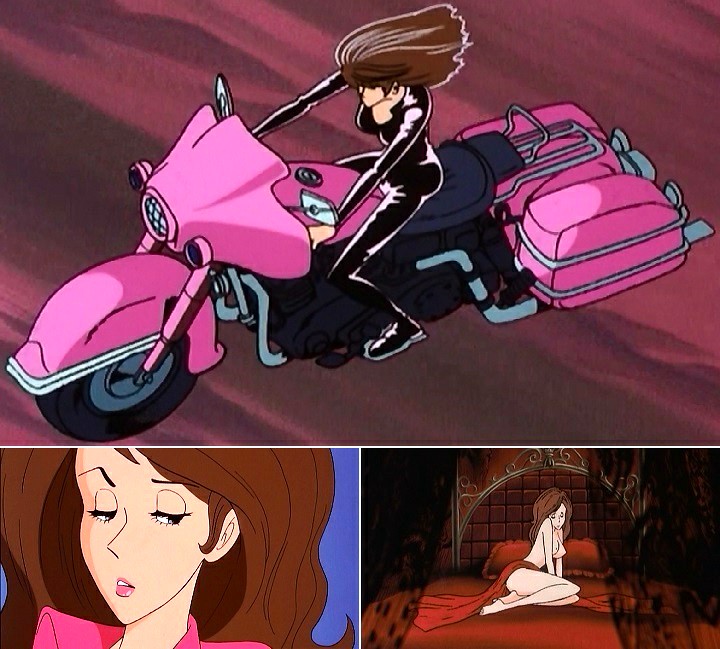
Rating: good. For two thirds of its run time The Mystery of Mamo is a highly entertaining romp, full of surreal visual gags, fun characters headed by the sexy Fujiko Mine, nicely animated action sequences and great music. Editing issues have a jarring effect from time to time, while the main villain dampens the fun without increasing the tension as he becomes more prominent in the last third. Don't be put off by that: the film is fun from start to finish; just more so early on. Resources: Lupin the 3rd: The Mystery of Mamo, Discotek ANN The font of all knowledge The Anime Encyclopaedia, Jonathon Clements and Helen McCarthy, Stone Bridge Press via Kindle Recommended reading: Lupin the Third: The Complete Guide to Films, TV Specials and OVAs, Reed Nelson, ANN Last edited by Errinundra on Mon Nov 30, 2020 7:18 am; edited 2 times in total |
||||
|
||||
|
Errinundra
Moderator
Posts: 6580 Location: Melbourne, Oz |
|
|||
|
The Melbourne International Film Festival is showing two anime films this year: Masaaki Yuasa's Lu over the Wall and Mamoru Hosoda's Mirai. I've got a ticket to Mirai, however both screenings of the Yuasa film are during work hours. Them's the breaks. I also ordered and received from CDJapan the Anne of Green Gables OST (which is terrific) and a collection of songs from The Star of the Seine (not so much). Anime has many strands; this grand survey has given me a whole new perspective into its history.
Splash of Crimson #11: Françoise Arnoul (aka Cyborg 003) 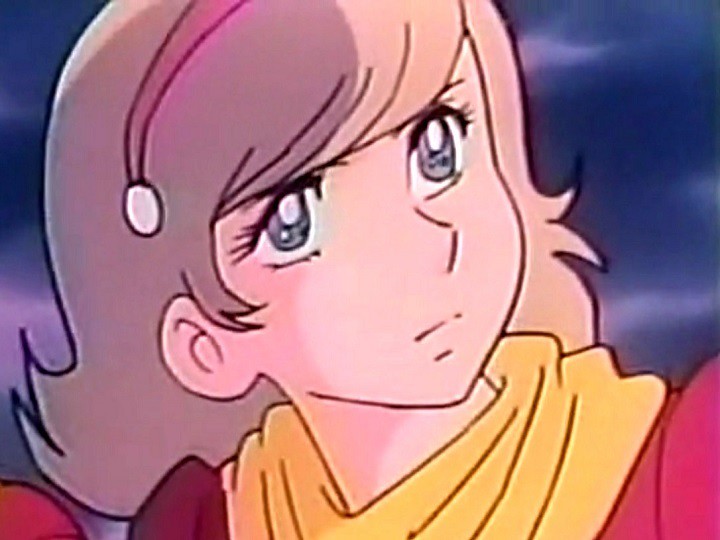
Cyborg 009 (1979 TV series) Synopsis: The series can be broken down into three parts. 1. The arrival of ancient Norse gods controlling golem-like monsters in various European locations, culminating in a showdown between the "gods" and the cyborgs at Yggdrasil, a giant mythical tree somewhere in Scandinavia (episodes 1-9). 2. The re-appearance of the cyborgs' original foes from the 1960's movies, now called the Neo Black Ghosts, presented mainly as a villain of the week scenario (episodes 10-42 or thereabouts). 3. The escalation of the tussle with the Neo Black Ghosts leading to a confrontation with its ruling triumvirate: Brahma, Shiva and Vishnu (up to the final episode 50). Production details: Premiere: 6 March 1979 (between Beautiful Fighting Girl #24, Lunlun the Flower Child and Beautiful Fighting Girl #25, Isabelle of Paris) Director: Ryousuke Takahashi (probably best known as the creator and ongoing director of the Armoured Trooper Votoms franchise) Studio: Toei, Sunrise Source material: the manga Saibogu Zero-Zero-Nain by Shotaro Ishinomori, in various magazines, July 1964 - 1981 Script: Akiyoshi Sakai, Haruya Yamazaki, Masaki Tsuji, Sakurai Masaaki, Soji Yoshikawa, Toyohiro Ando and Yoshiaki Yoshida Music: Koichi Sugiyama Character design and animation supervisor: Toyoo Ashida (Heidi - Girl of the Alps (CD & animation director), Space Battleship Yamato (AD & AS), Fairy Princess Minky Momo (CD), Vampire Hunter D OAV (director) and Fist of the North Star (Dir), among numerous other titles and roles) Note: I watched episodes 1-35 via fansubs, whereas episodes 36-50 were unavailable subbed. For the latter I had a choice between an Italian or Japanese audio track. I chose the Japanese version. The lack of subtitles was frustrating as I haven't properly grasped what happened at the series climax and resolution. As with similar cases in the past, this will have affected my judgement of the series. 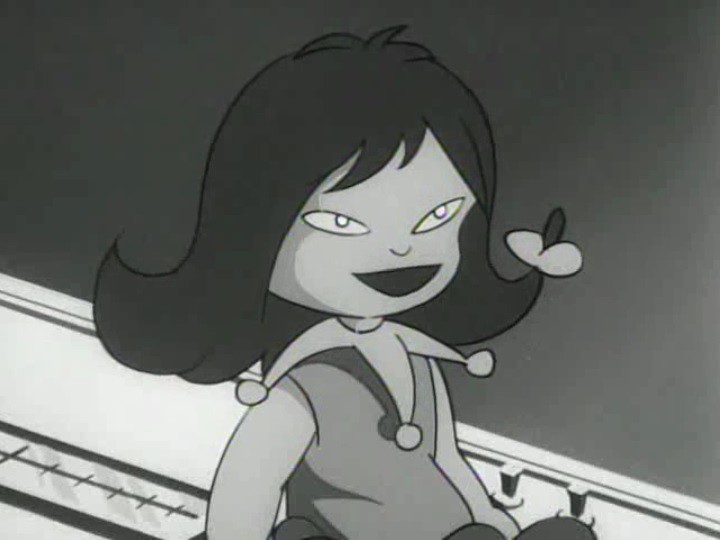
The PTA villain from the last episode of the original series. 1968 series revisit: (Please indulge me - there is some relevance to the 1979 version.) In my review of the older series I drew attention to the occasional episodes that, with their cold-war scenarios and pointed messages, transcended the otherwise villain of the week formula. The stand-out episode 16, "Ghost of the Pacific", mocks Japan's militarist right wing while displaying images of the Hiroshima Peace Park. The series was broadcast on what was then known as NET, ie Nihon Educational Television Co., Ltd, whose licence required them to emphasise educational programming. The model had proven a failure so the company began showing anime such as Cyborg 009 as part of its regular programming. The political stance of the series upset PTA groups who complained to NET. The company in turn directed the staff to tone down the content. Instead, the staff pulled the pin on the series, ending with a delirious episode 26 where an alien - depicted as an evil, doll-sized PTA mother - leads two superpowers into total nuclear war. By the time the second series aired NET had transformed into TV Asahi, with a regular broadcast licence. Episode 16 wasn't shown again for decades. Comments (1979 series): The immediately obvious change is the introduction of colour along with an accompanying re-design of the characters. To put it simply, they have been bleached. Everyone bar the bald 007 (aka Great Britain) and 005 (Geronimo) has had their hair lightened; some substantially. With the franchise's exotic cast and settings I wonder if these changes were intended to enhance the foreign appeal for both the domestic and possible overseas audiences. In addition, Great Britain is no longer a child while 009 (Joe Shimamura) has grown from shounen to seinen. Both are welcome changes. The uniforms have become, well, uniform. Where earlier Françoise (003) was the splash of crimson and Joe the splash of white in an otherwise purple squadron (in the movies, anyway), all are now in vibrant red with glowing, flowing, impossibly impractical yellow scarves. While I love the colour combination I kept thinking about the fate of Isadora Duncan. I supppose cyborgs don't easily break their necks. 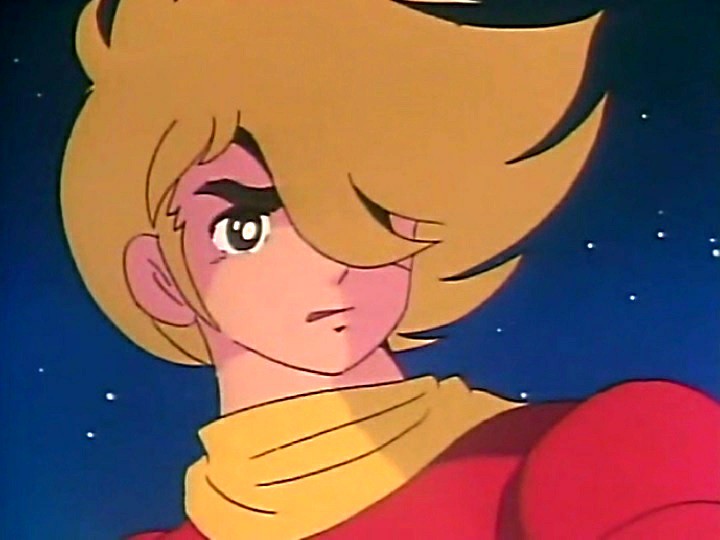
Joe is a little older, a little more the streetfighter There are other changes: some good, others perhaps not so. Along with the colour and the hair styles, the overall appearance has been updated to meet the aesthetic standards of 1979. The character designs retain their overall 1960s goofiness, but, to my 21st century eyes, the anime looks dated without a mitigating aura of strangeness. Rainbow Sentai Robin, by way of contrast, has the feeling of being made by a civilisation lost to time. Character designs aside, the artwork, animation and backgrounds are superior to any of the Go Nagai series I've recently watched, though not in the same league as Lupin the 3rd: The Mystery of Mamo, which, of course, had the benefit of a more generous movie budget. And, on the subject of the Go Nagai giant robot shows, while Cyborg 009 shares their episodic villain of the week structure for much of its run, the individual stories are somewhat more sophisticated and thereby more engaging to this viewer. The series eschews the Cyborg 009 franchise's former penchant for space alien villains; instead giving us Norse "gods" and a trio of taciturn cyborgs whose singleminded desire for chaos runs counter to their supposed intelligence. That cyborgs can be humane, godlike or demonic is a simple message directed at a schoolboy audience. Perhaps I'm being unfair judging Cyborg 009 with my adult sensibilities. That may be why my biggest disappointment is the excision of any overt political commentary. In its place the newer series gives us generalised freedom versus oppression scenarios that have been done to death in all sorts of entertainment media over the decades. The uncontestably evil villains are no longer controversial; they simply want to rule the world by force. Kill the villains and you win the argument. The removal of the earlier show's satirical content suggest the PTA warriors won that particular contest. There are episodes with the potential to make political points, namely episodes 26 and 28 set in the Middle East and Africa respectively. Both end up as mundane action episodes with a conventional antagonist. The creators have also moderated the deliberately fanciful hyperbole of the earlier Ishinimori adaptations while nonetheless attempting to raise the conflicts to epic levels. For a time that worked. The early episodes, where it seemed that the cyborgs were genuinely confronted with beings of divine power, and with an accompanying ominous tone, are the best of the series. The concept of man-made superpowered machines pitted against supernatural beings genuinely tantalised me. Alas, and again, the series squibbs out; the "gods" turned out to be more mundane than I had hoped. I'd love to see an anime where the gods are torn from their heaven. (Is that part of the appeal of Akemi Homura?) Odin, supposedly destroyed at the end of the first arc, makes unexpected, redundant appearances in the last few episodes, reflecting the creators' original aim of finishing with a return to the Norse story line. It wasn't to be. Sunrise pulled out of the production, forcing them to wind up the series prematurely. The resulting rushed climax between the cyborgs, the Neo Black Ghost triumvirate and their saintly alter ego Gandal, lacks the power that may have been achieved had the makers had more broadcast time at their disposal. This problem will become a feature of anime in the next little while, affecting such TV shows as Space Runaway Ideon, Mobile Suit Gundam and Fairy Princess Minky Momo. 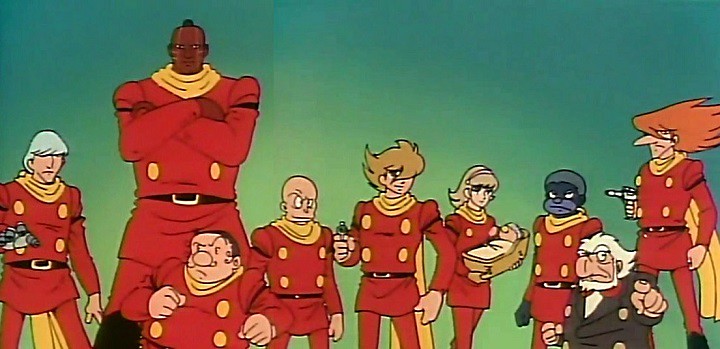
The cyborg team (l-r): Albert Heinreich (004); Geronimo Junior (005); Chang Changku (006); Great Britain (007); Joe Shimamura (009); Françoise Arnoul (003); Ivan Whisky (001); Pyunma (008); Dr Isaac Gilmore; and Jet Link (002). Naturally enough, the eponymous Cyborg 009 / Joe Shimamura is the central focus. We get some of his back story, prior to his cyberisation by the Black Ghosts. Turns out he was a delinquent, spending time in a juvenile detention centre until his adoption by a scientist. He's also a champion racing car driver. Delinquent youth and sports star seems to have been a popular combination in the 70s. The parallels with his namesake Joe Yabuki from Ashita no Joe are obvious. 1979s cyborg Joe has gravitated from his earlier Peach Boy incarnations towards the wilder boxing Joe, without ever managing to becoming the latter's charismatic monster. We also get back stories on other cyborgs, namely Françoise (a ballerina), Great Britain (a failed Shakespearean actor), Geronimo Junior in the American west and Jet Link (a New York gang member). Jet takes over from Great Britain and Chang Changku from the 1968 series as the most important character after Joe. This time around he's Joe's best mate, what with their shared former delinquency and car racing rivalry. He also proves himself to be hot-headed in a crisis. The other cyborgs must constantly restrain the American from rushing into battle without thinking. Maybe there's a global political point being made? As one of three cyborgs who can fly - Great Britain can transform into a bird and Ivan Whisky can levitate - and supersonically at that, he is prominent in most battle scenes. As ever, the strongest and weakest character is Ivan Whisky. Strongest in the sense that his psychic powers are near omnipotent. He can predict the future, levitate, teleport people and objects and sense distant activities (thereby rendering Françoise superfluous to needs). He is to this franchise what Yuki Nagato is to The Melancholy of Haruhi Suzumiya: the deus ex machina to be deployed whenever a rabbit needs pulling from a hat. That's one reason he's also the weakest character. The franchise, understanding the problem, limits his power by having him sleep most of the time, something neither he nor the other members of the team can control. This leads to the other reason: a one-year-old super brain just can't leap the credibility gap, both conceptually and visually. His mere existence means the franchise can't ever be taken seriously. Why would anyone, even as demented as the Black Ghost, want to turn a dead twelve-month-old into a cyborg? 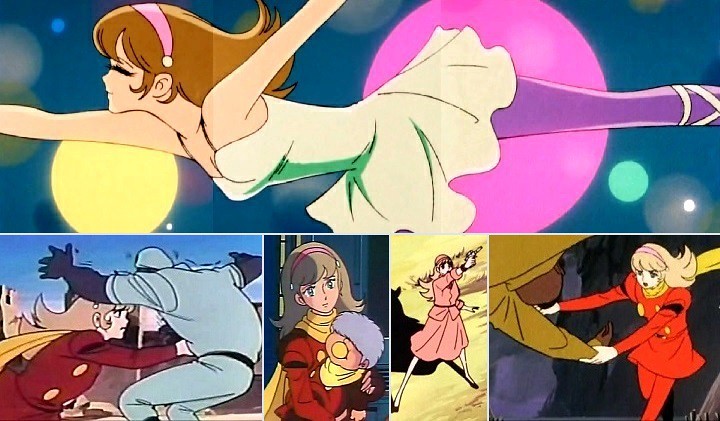
Despite being proficient in the martial arts Cyborg 003 spends most of ther time in the background. Françoise Arnoul: Cyborg 003 remains a minor character and a disappointment. She is given only occasional focus and has little responsibility, despite her obvious abiliities. Nor is she given the cheesecake role played by Yuki Mori in Space Battleship Yamato or become the source of sexual tension in the manner of the Go Nagai females. Sure, she's eye candy as a ballerina, but we're talking a few seconds in 50 episodes. Likewise the fist to the solar plexus and the judo throw shown above aren't typical of her normal roles and behaviours. In the first half of the series she spends most of her time at headquarters with Doctor Gilmore and Cyborg 001 as a sort of General Staff to the combatants in the field. As conflict with the Neo Black Ghosts escalates she spends more time on the front line, so to speak. To be fair her wide range of abilities is impressive, but she's no longer a pioneer as a beautiful fighting girl. In 1979 the torch was carried by Maetel (Galaxy Express 999), Fujiko Mine (Lupin the 3rd: The Mystery of Mamo) and Oscar François de Jarjayes (The Rose of Versailles). Kenji Kamiyama will re-imagine her in a spectacular new way in 009 Re: Cyborg, but that's 33 years into the future. Rating: So-so. The introduction of colour and other technical improvements put this series ahead of the first season on most measures, but the franchise's previous 1960s counterculture sensibility has been diluted. The character designs, however, remain resolutely stuck in the preceding decade, while more interesting character and narrative developments were taking place elsewhere at the time. Resources: ANN The font of all knowledge Cyborg 009 Wiki 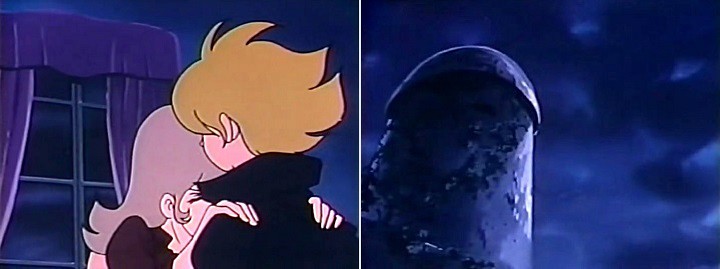
Go Nagai style unsubtle moment. As Françoise clings to Joe, the scene jumps to the villain's lair. Last edited by Errinundra on Mon Aug 16, 2021 5:09 am; edited 3 times in total |
||||
|
||||
|
Errinundra
Moderator
Posts: 6580 Location: Melbourne, Oz |
|
|||
|
Mirai
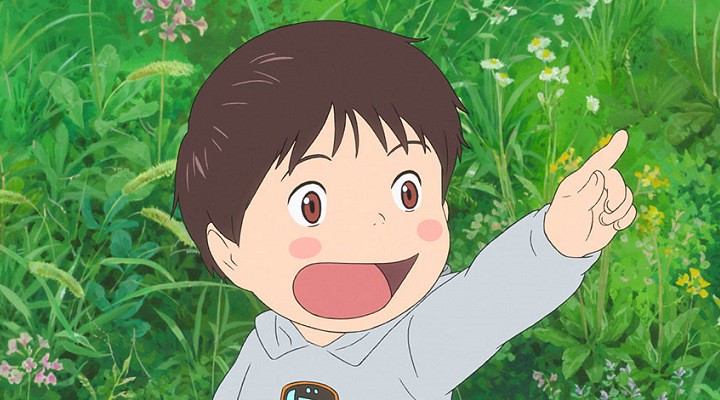
Reason for watching: Because it's directed by Mamoru Hosoda, whose career I follow; and because it was showing at the Melbourne International Film Festival. As with other viewings of one-off screenings, please consider this an impression rather than a review. Synopsis: Pre-schooler Kun finds himself demoted from darling to afterthought when his mother comes home from hospital with his new baby sister, Mirai. With his work-from-home architect father too harried and and his nursing mother too occupied to satisfy his cravings for attention, Kun becomes ever more resentful of the new intrusion. Before things get out of hand, Kun has an unexpected visitation from a furry, followed by a future version of his sister. Things get even more hair-raising for Kun when he is transported into the past to meet members of his extended family. A nightmare journey to Tokyo Railway Station reveals to Kun that family ties are deeper than sibling rivalry. Production details: Premiere: 16 May 2018 Studio: Chizu Director / screenplay / creator: Mamoru Hosoda (The Girl Who Leapt through Time, Summer Wars, Wolf Children, The Boy and the Beast) Music: Masakatsu Takagi Character Design: Hiroyuki Aoyama Art Director: Takashi Omori and Yohei Takamatsu Animation Director: Ayako Hata and Hiroyuki Aoyama Comments: Mirai marks the fourth release in Mamoru Hosoda's run of films about family dynamics. In each the routine of daily life is embellished with magical occurences, or science fiction in the case of Summer Wars, that provide Hosoda with the opportunity to explore the relationships in entertaining ways. Mirai doesn't disappoint in that area, although how the magic is introduced, deployed and resolved is somewhat different from his previous films. One of the problems I had while watching the movie was that, not realising the source for the magical erruptions, Kun's experiences seemed to me gratuitous, even forced. In retrospect I've figured that the enclosed courtyard garden was the site of the transformations, both temporal and spatial. I think the issue was my own obtuseness, not any failing on the director's part. That's the disadvantage of a one-off screening in a theatre: I can't re-watch a scene to catch what I'd missed first time around. Irrespective of my own shortcomings, the garden plays the transformational role of the nut from The Girl Who Leapt through Time, computers into the virtual world of Oz in Summer Wars, the wolf man in Wolf Children and the laneway in The Boy and the Beast. You could think of them as portals to a suburban-safe surreal realm of the imagination. Sure, they're mildly threatening places, but they don't visit the darker places of the human psyche in the way the witch's mazes do in Puella Magi Makoka Magica. More a chamber work, the magic world of Mirai isn't as flamboyant as Hosoda's own predecessors, such as The Boy and the Beast or Summer Wars. 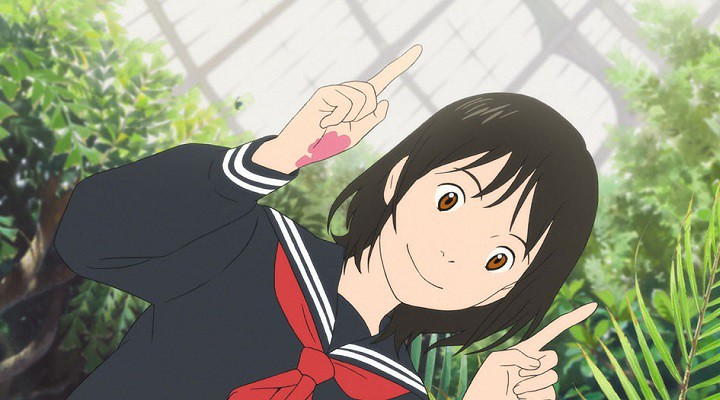
Get ready for... tickle torture! (The birthmark on her hand tells the viewer who she is.) The reduced scale makes the film both riskier and less ambitious. The small cast and mostly enclosed domestic setting means that the film relies heavily on the appeal of the characters to succeed. I'll deal with Kun presently, but the others are a mixed bag. Most entertaining are the rumbustious, capering furry and the BMW riding, physically handicapped yet charismatic great-grandfather of family legend. While important to the story - the former announces Hosoda's general thesis while the latter suggests to Kun new ways of approaching problems - neither are central. Less amusing are Kun's unnamed parents. Both are overwhelmed by the responsibilities of child-rearing. His mother, who is the more headstrong of the two parents, becomes, in Kun's imagination, a demonic hag, while his domestically inept and physically unco-ordinated father is a more comic creation. Neither have much depth, although a childhood vignette reveals the mother has some mettle to her character, and a rebellious streak to boot. As a baby, Kun's eponymous sister is little more than a plot device. She has considerbly more narrative and amusement value in her "older" sister form, though she doesn't stray too far from anime schoolgirl norms. How she inveigles Kun to help preserve her marriage prospects is a treat (as is the entire sequence). Their chemistry together is workable without shining. Kun, voiced by 18-year-old female seiyuu Moka Kamishiraishi, is problematic. I get that a teenage female voice is more convincing than a male's for young children of either sex but, for a good portion of the film, I thought Kun was a girl (despite the name and his obsession with bullet trains - hey, I saw the film after a tiring day at work, so clearly my brain was having trouble processing stimuli). The issue was exacerbated by Kamishiraishi sounding both too old and too sophisticated for a three-year-old child, particularly in the second half. The sophisticated speech is, of course, a problem with Hosoda's script, so shouldn't be slated home to the seiyuu. The next issue is inherent in having such a young protagonist. The film makes a brave attempt at getting inside the child's mind, but, while highly amusing, it never quite convinces, leaving this viewer with an adult detachment. It meant that I never had a handle into the film, something that is necessary in a sentimental family dramedy. In short, I didn't invest emotionally in Kun. The third issue is the nature of the magic on display. In his previous four films, the magic / power was identifiably external to the protagonist, enabling them to project themselves beyond normal constraints. Mirai is vague on the matter. Is the source of Kun's visions external? If so, Hosoda doesn't reveal what it is (beyond its possible location in the garden) thereby leaving my curiosity unsatisfied. Is it, then, internal? That's even less convincing. It barely seems credible that Kun could conjure in his mind the events I saw on screen. Don't be put off by my reservations. Mirai does other things well. Above all, it's a funny film. The architecture of the stylish but impractical house is especially suitable for pratfalls, as if Buster Keaton had assisted Kun's father in inflicting the design upon the family. I was amused how parts of the house had adjacent sets of steps separated by a wall. If anyone - think three-year-old - wanted to get to the adjacent area, they would have to go up the steps, then down again. Physical humour is a feature of the film, both in that pratfall sense and in the exaggerated movements and expressions of characters, especially in the magical sequences, something Hosoda has carried over from The Boy and the Beast. The film captures well the physicality yet precarious mobility of a pre-school child. The magical sequences fit in neatly with Kun's otherwise quotidian life, but the viewer is always aware when the flights of fancy occur. The Tokyo Station scene is the most stylised, most surreal and - appropriately - most threatening of the sequences. As the climax of the film and the moment of crisis for Kun, it is more organically embedded in its narrative structure than the analogous parts of Hosoda's three previous films. I always felt the falling satellite in Summer Wars, the typhoon in Wolf Children and the whale's appearance in The Boy and the Beast were tacked on catastrophes intruding upon captivating family dramas and whose sole purpose was to have the films go out with a bang. In Mirai, Tokyo Station becomes both a metaphor for the choices facing Kun and a surreal representation of his state of mind. 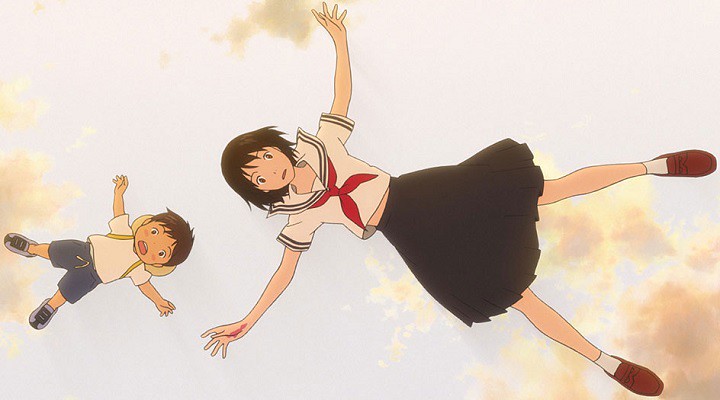
Rating: A maybe too generous very good. I want to re-watch Mirai again to better understand some of the narrative elements that I may not have fully grasped. A re-watch would also indicate whether one of its best qualities, the humour, continues to stand up. Overall, a mixture of fun and prosaic characters, a sweet portrayal of sibling jealousy, an attractive visual package and beguiling magical transformations make for an amusing experience. The choice of such a young point of view character may leave the viewer viewing the events in a detached, ironic manner. Perhaps that is Hosoda's intention? Or, maybe its because, having never raised a family, I didn't relate to the events depicted. I'm left wondering who the intended audience is. Resources: MIFF - the images are from their website ANN The font of all knowledge |
||||
|
||||
|
Errinundra
Moderator
Posts: 6580 Location: Melbourne, Oz |
|
|||
|
Splashes of Crimson #12: Fujiko Mine and Clarisse d'Cagliostro
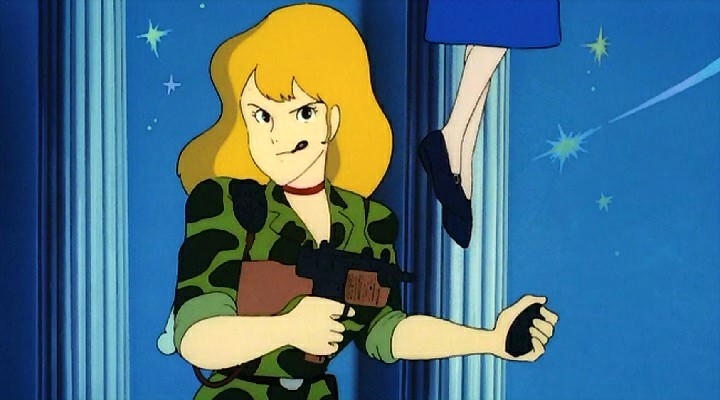
Contrasting images of womanhood: with machine gun in one hand, grenade in the other and the pin between her teeth, Fujiko singlehandedly holds off the villains as demure, marriage-fodder Clarisse is hauled to safety. Lupin the Third: The Castle of Cagliostro Synopsis: When his booty from a casino heist turns out to be counterfeit Lupin decides to investigate the rumoured source: the tiny Duchy of Cagliostro. Complication finds Lupin when, en route, he encounters a young woman in a bridal outfit pursued by a gang of men. Turns out Clarisse is the heir to the Duchy on the eve of a forced marriage to her relative, Count Cagliostro. He's got designs on ruling the Duchy and reaping the benefits of its vast wealth potential. Lupin sets out to uncover the many secrets of the castle of Cagliostro. As ever he's assisted by the katana-wielding Goemon and gunslinger Jigen, while Fujiko pursues her own agenda, and Zenigata pursues Lupin. Production details: Premiere: 15 December 1979 (between Beautiful Fighting Girl #26, Oscar François de Jarjayes, and Beautiful Fighting Girl #27, Lalabel Tachibana) Director / original story / storyboards: Hayao Miyazaki Studio: TMS and Telecom Animation Film Source material: Lupin III by Monkey Punch (Kazuhiko Kato) in Weekly Manga Action, 10 August 1967 to 22 May 1969 Original concept: Maurice Leblanc Script / screenplay: Hayao Miyazaki, Yasuo Otsuka and Haruya Yamazaki Character Design: Hayao Miyazaki and Yasuo Otsuka Art Director: Shichirō Kobayashi Animation Director: Yasuo Otsuka Music: Yuji Ohno 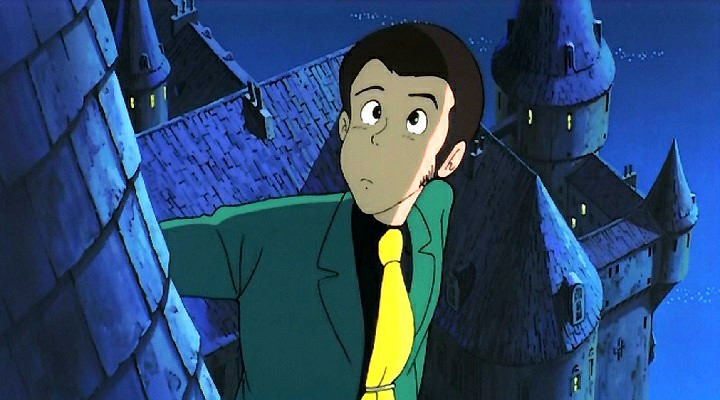
Yasuo Otsuka: My Madman DVD release of the film contains a bonus interview with the animator from 2006. Born in 1931 he worked at Toei from their very first feature animation, The Tale of White Serpent. He gained a reputation for comical villains with his unintentionally humorous skeleton in Magic Boy and came to the conclusion that genuine realism needed to be replaced by "constructed realism" in anime. He went on to be animation director or character designer in Alakazam the Great, The Littlest Warrior, Horus - Prince of the Sun, Lupin III (TV - 1971), the Panda! Go, Panda! movies, Lupin the 3rd: The Mystery of Mamo and Chie the Brat (to name the titles I've reviewed). He later became a trainer at Studio Ghibli and wrote important memoirs of the anime industry of the 1960s and 70s. Otsuka has little time for the modern anime industry, believing that the production system and the ease of modern life stifle creativity. Proud of the original series and The Castle of Cagliostro, he praises Miyazaki's storyboards in particular. He opines that the ensemble characters of the franchise need to be allowed to do their own thing, otherwise it becomes formulaic. He characterises the subseqent franchise as shit trailing behind a goldfish. Comments: Being immersed this time around in 1970s anime, the thing that struck me most profoundly in this re-watch after seven years is how much a technical leap it is compared with its contemporaries. I had a similar reaction when watching Heidi, Girl of the Alps from 1974 for this project. It's no surprise then that Hayao Miyazaki was involved with both. In Cagliostro you can see his meticulous, detailed hand in the layouts and framing that create a spacious grandeur, in the glowing, slightly artificial palette that makes it seem more true and evocative than it would otherwise, and in the jauntily amusing animation and in its sure-footed pacing. It's fun comparing the famous car chase scene with its counterpart from The Mystery of Mamo. They're equal parts fun, but the gags from the newer film arise largely from the animation whereas the older film must depend more on the situations and shout-outs, though it has its animated moments. Cagliostro also lacks the awkward jump cuts of its predecessor, while the fantastical plot developments never fall outside the viewer's suspension of belief. Miyazaki gives us a poised and assured cinema debut. 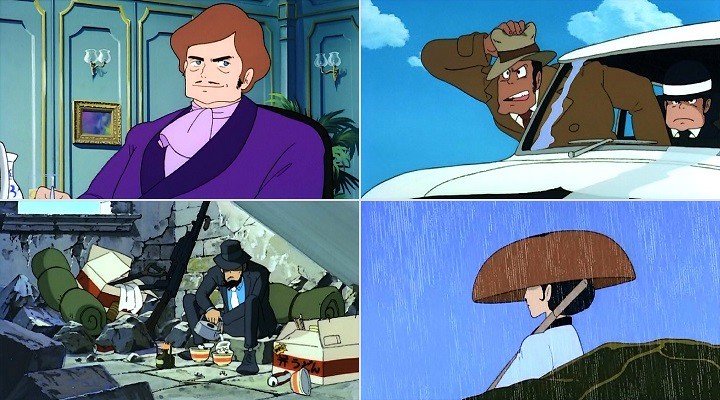
Clockwise from top left: Count Lazare d'Cagliostro, Zenigata, Goemon, Jigen. Miyazaki also sets his stamp on the much loved ensemble cast. I'll come to the female characters in due course, but, unfettered by other people's vision of the franchise - compare with the 1971 TV series where he and Takahata took over the stumbling series - he can present them as he sees fit. All five of the regular crew are now softer, more rounded in their appearance. Most traces of the previous, deliberate coarseness have been smoothed out: Lupin's hairy skin, the knobbly joints and stick-like limbs, the leering expressions, the nudity and the sexuality. Lupin has gone from the villain of the early episodes of the original TV series, via the unscrupulous rogue of Mamo, to the endearing heart of gold we get in this instance. He's even had his racey red jacket returned to the wardrobe. Even if I were to prefer the more ambiguous version of Lupin all is forgiven thanks to the sheer entertainment of the film's capers. A good example of the softer approach by Miyazaki can be seen in the responses of Goemon, Jigen and Zenigata to Clarisse's sweetness. Goemon and Jigen, whose misogyny is a trope of the franchise, melt when Clarisse thanks them for their kindness. Their embarrassed, self-conscious reactions are a comic highlight. Zenigata gets the best, most sentimental line of the movie when he describes to Clarisse what Lupin has stolen from her. Indeed, Zenigata is a revelation, temporarily becoming Lupin's ally (for a shared, worthwhile goal) and, for the first time, a genuine hero with his righteous defiance of the United Nations. It's this Miyazaki optimism, rather than the Monkey Punch cynicism, that shines in Castle of Cagliostro. And there's no preachiness. Miyazaki avoids his later penchant for overloading his films with thematic density. The villain, the Count of Cagliostro, is a chubbier version of Muska from Laputa: Castle in the Sky. His nuances go no futher than being coldly evil with a taste for refinement. He is a personable fellow so makes for a more entertaining villain than the preposterous Mamo. Miyazaki adds variety through the Count's minions - an obsequious, incompetent secretary, a square-jawed, dumb but capable captain of the palace guard and a gang of alarming claw-handed assassins. The eponymous castle is quite the character itself, with its mysterious plumbing, bottomless dungeons home to a vast array of corpses, and the serried towers.There are elements of Bluebeard's Castle in the setting and narrative, although, as with everything else, the sexual elements are downplayed. Yuji Ohno provides another jazzy soundtrack that is entirely apt. Standout is the sultry, nostalgic opener Honoo no Takaramono. There's also a short piece where both the motif and variations owe much to Mike Oldfield's Incantations album, released only the year before. Ohni, on only his third contribution, is by now a dependable element of the franchise. 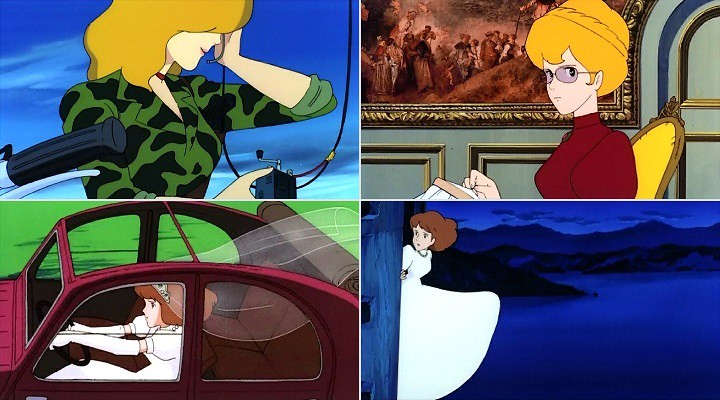
Top: Fujiko in Amazon and house-mistress forms. Bottom: Clarisse - ever the damsel in distress. Clarisse d'Cagliostro and Fujiko Mine: The two female characters are weaker elements of the film, which is disappointing given Miyazaki's reputation for quality female characters. Design-wise Clarisse owes a little to Anne Shirley from Anne of Green Gables (though not the personality) and will, in time, become the template for the much superior Nausicaa (Nausicaa of the Valley of the Wind) and Fio Piccolo (Porco Rosso). Like the other non-core Lupin characters, she is a typical Miyazaki design. For all his artistic ability, Miyazaki likes to recycle character designs. That's not the real problem, though. Clarisse is a cipher: her roles are prisoner, bride, rescue-object and idoliser. She is sweet, demure, dutiful and quiet. It's as if, uncomfortable with the avowed sexuality of Fujiko, Miyazaki decided to contrast her with his vision of ideal womanhood. If so, happily his vision will expand considerably in future work. Somewhat more interesting than Clarisse, Fujiko has been massively de-emphasised from Mamo. In fairness to Miyazaki, she remains as important as the other two members of Lupin's cabal, Jigen and Goemon. Again it's as if Miyazaki were conducting some sort of culture war within the franchise to have his vision prevail. For the first time Fujiko has no romantic role to play. (She tells Clarisse she dumped Lupin.) Instead she is limited to her characteristic spoiler role in the quest for the banknote printing blueprints. She appears in two forms - as a prissy domestic servant in the Count's employ while she searches for the plans and as a deadly gun-toting Amazon warrior once Lupin starts his mayhem. She's also turned blonde. I guess you can't have two female characters with red hair, which indicates who is the more important to Miyazaki. That said, Fujiko is threatening; Clarisse is sweet. Fujiko has agency; Clarisse has none. Fujiko is active; Clarisse is docile. Although neither are particularly appealing, Fujiko is entertaining because of what she does; Clarisse for what happens to her. 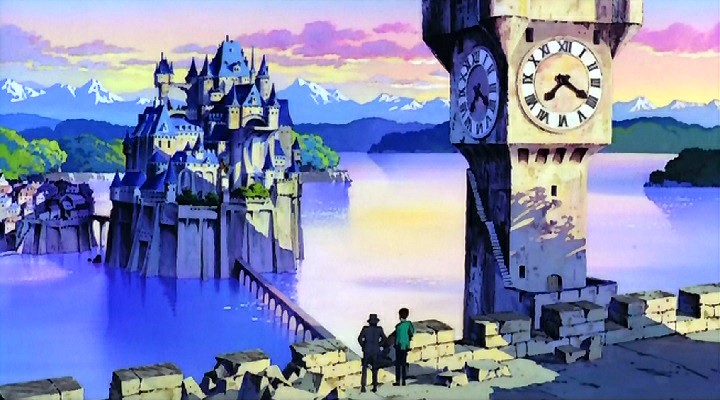
Rating: very good. The Castle of Cagliostro carries its age very well, in part because Miyazaki's remains influential and his key visual styles are established in the movie, but also because it is so handsome. Not bogged down by any of Miyazaki's ideological fixations, the film entertains from start to finish. What might be cliched tropes under a different director are here animated with verve and aplomb. Resources: Lupin the Third: The Castle of Cagliostro, Madman ANN The font of all knowledge The Anime Encyclopaedia, Jonathon Clements and Helen McCarthy, Stone Bridge Press via Kindle 500 Essential Anime Movies: the Ultimate Guide, Helen McCarthy, Collins Design Last edited by Errinundra on Mon Aug 16, 2021 5:10 am; edited 3 times in total |
||||
|
||||
|
Errinundra
Moderator
Posts: 6580 Location: Melbourne, Oz |
|
|||
|
Splash of Crimson #13: Olga
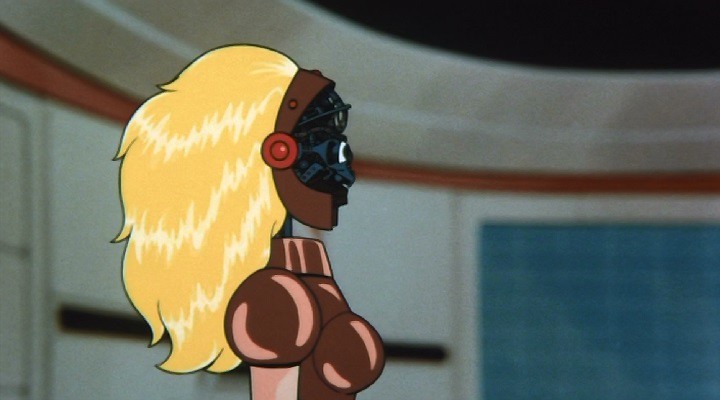
Don't be alarmed. Her face is in the process of forming. Space Firebird 2772 (Hi no Tori 2772: Ai no Kosumozo:n, perhaps Firebird 2772: Love's Cosmic Lifeforce) Synopsis: In a brave new world, Godoh is conditioned from the day of his test tube birth and later trained to be a space fighter pilot. His only childhood companion is the faithful, beautiful robot, Olga. When Godoh falls in love with Lena, a woman who has been promised as wife to an up and coming politician, he is banished to the hellish magma mines of Iceland, the hoped for source of energy for a dying Earth. He is given the opportunity of a reprieve if, using his skills as a space pilot, he finds and captures the legendary space phoenix whose blood is reputed to grant eternal life. Assisted by Olga he will battlle the phoenix, bringing incineration, death, destruction, rebirth and renewal. Production details: Premiere: 15 March 1980 (between Beautiful Fighting Girl #27, Lalabel Tachibana, and Beautiful Fighing Girl #28, Chie Takamoto) Original story, story line and general direction: Osamu Tezuka Director: Suguru Sugiyama Studio: Tezuka Pro Source material: Hi no Tori (Firebird or Phoenix) - Tezuka considered the unfinished project as his "life's work"; the film is better considered as a spin-off, rather than an adaptation. Screenplay: Osamu Tezuka and Suguru Sugiyama Music: Yasuo Higuchi Animation Director: Kazuko Nakamura and Noboru Ishiguro (director of Space Battleship Yamato, Super Dimension Fortress Macross and Legend of the Galactic Heroes, among other things) 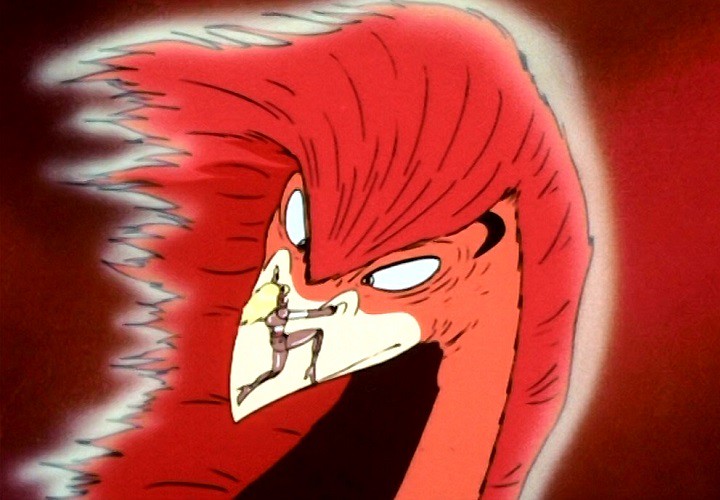
Olga confronts the Firebird. Notes on some of the names: The Japanese title of the film is 火の鳥2772 愛のコスモゾーン. The final characters ゾーン (pronounced as zōn) are almost always rendered in English as "zone", which makes no sense in the context of the film or the title itself: the phoenix is creation's life force, not a location. Tezuka himself clarified the matter when he explained that it was a play on the classical Greek word for animal, zoion, which, in turn, is derived from the word for life. Tezuka also stated that Godoh's name was inspired by Samuel Beckett's play Waiting for Godot, which may have been flippant, although it might be argued that the earth's renewal is awaiting Godoh's intervention. Olga comes from the Norse name Helga, meaning "holy, blessed". Comments: Born in 1928 in Osaka, Tezuka endured the firebombing of the city in World War 2. He also lived through the subsequent "Japanese Miracle" that saw the nation become the world's second largest economy. Hence, it isn't surprising that death and rebirth are constant themes in his work, or that the phoenix should be such a central figure. You can see the renewal theme in such works as Tales of the Street Corner, Kimba the White Lion, Marvelous Melmo (where the phoenix has an essential role), and the Buddha films, to name some that I've reviewed in this thread. To that I would add my favourite Tezuka quote, What I try to [say] through my works is simple… just a simple message that follows: "Love all the creatures! Love everything that has life!" I have been trying to express this message in every one of my works. For Tezuka, the phoenix is the incarnation of love, the creative force, the bringer of life and death. Hayao Miyazaki would create a variation on the theme with his Forest God / Nightwalker from Princess Mononoke. So, we're talking big themes and big ideas here. Going further, the depiction of annihilation as a precursor to renewal will be played out famously in the next anime I'm reviewing, Space Runaway Ideon, as well as titles as disparate as Neon Genesis Evangelion and Puella Magi Madoka Magica. 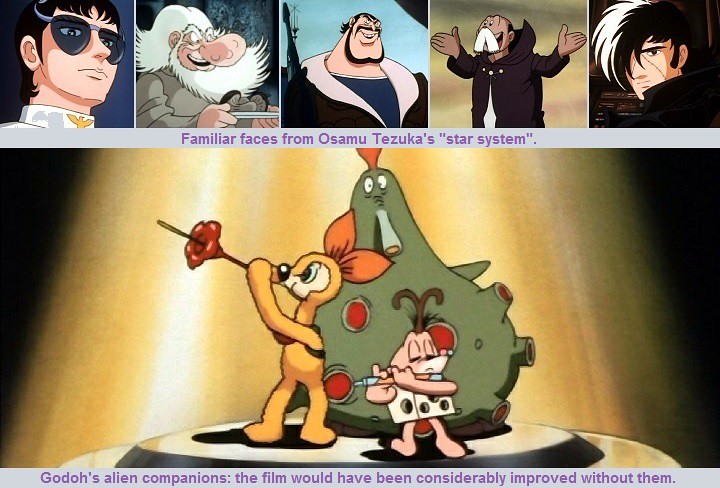
That ambition is matched, to an extent, by the film's production. In several scenes the backgrounds are fully animated. Not just panned or multi-planed, but fully painted: when a car drives down a highway, the scenery approaches and whizzes past; when a person moves around a room the walls rotate around them. The exterior shots of Godoh's spaceship - the Shark - are computer generated and the studio avails itself of rotoscoping (though these days the technique has acquired an underserved bad reputation in anime). Space Firebird 2772 is an innovative film for its time and, in patches, an impressive achievement even to this day. At other times it hasn't aged at all well. Many of the characters are stuck in the Tezuka 1950s and 60s design time warp. The musical interludes are reminiscent of the worst efforts of Toei from that same era, although I should be grateful that the cutesy alien animals don't sing. Likewise, the numerous joke scenes as often as not add little to the film other than drag it out. At two hours the film could be much leaner. and, for all the innovation, at times the animation and artwork are just plain bad. As with earlier Tezuka films, there's a mixture of brilliance and poor judgement. The contemporary Castle of Cagliostro is, overall, a better visual experience, but then Tezuka is taking more risks. The scene that, deservedly, gets most notice has 7½ dialogue-free minutes covering Godoh's creation in a test tube, his childhood indoctrination and conditioning, his meeting with Olga and ends with his enrolment at flying school. It's simple, and a visual story telling tour-de-force. If you include the initial images of the phoenix flying and the credits, the first spoken words - which are jarring when heard - are 11½ minutes into the film. Most modern of the character designs - that is it follows the aesthetic fashion of its time - belongs to the protagonist, Godoh. He's a variation on Joe Yabuki (Ashita no Joe), Koji Kabuto (Mazinger Z) and Susumu Kodai (Space Battleship Yamato). As protagonist and hunter of the phoenix he's quite the earnest character. There's a melancholy about him that I suppose the cutesy space aliens are meant to mitigate. Conceptually his role is to destroy his quarry. Tezuka's worldview isn't about eternal life; it's about renewal. The phoenix must be destroyed for the earth to be reborn. Through its sacrifice it creates. Only when Godoh realises how genuinely he loves Olga is he able to subdue the phoenix, which becomes powerless and submissive when confronted with love. Yeah, that's cheesy, but Tezuka's and Sugiyama's conviction manage to pull it off. Just. At the climax of the film, Godoh will have his own phoenix moment, thus embellishing the central theme. 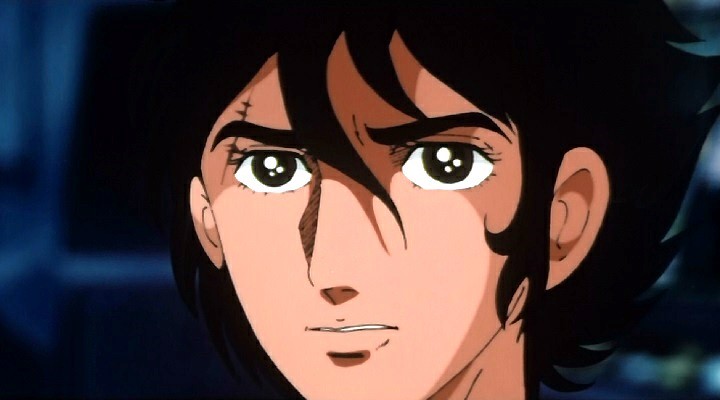
Godoh The film makes extensive use of Tezuka's "star system", whereby he re-uses characters from other stories, but with different contexts, back stories and even names. Think of it as using specialist character actors in live-action films: you've got an actor (or, in Tezuka's case, character design) who plays many roles over the course of their career, but usually of the same type. With a specialist character actor, you know what you're getting the moment they appear on screen. Rapid establishment of character types is essential to anime. In the last couple of decades moe stereotypes have filled much the same function as Tezuka's star system. Still, I find it weird seeing Black Jack as a villain. Maybe that's harsh. His black and white hair informs the viewer that he is ambiguous, and he does the right thing by Godoh eventually. Olga: Setting the animation innovations to one side, the film's best moments usually involve Olga. While she's every bit as serious in demeanour as Godoh, she is treated more comically. Her multiple transforming abilities, while vitally important on several occasions, are humorous. Godoh has a remote control that initiates her transformations. Well, think rapid channel surfing. My favourite moment is when, after saving Godoh from the Phoenix the first time, in this instance in rocket form, she lands, then must shake her nose cone to get her face and hair to re-appear and flick her rocket pods to turn them back into legs. The motions are cute and funny and sexy all at once. Now that's a cue to segue into her fetishy design. On one level Osamu Tezuka is something of a libertarian when it comes to sexuality or, to put it more bluntly, he has the eye of a dirty, old man. That's apparent in Princess Knight, Marvellous Melmo, Tales of a Thousand and One Nights and Cleopatra. I like her design all the same. She manages to combine that provocativeness with both a steely hardness and a maternal softness. I see her as a sort of spiritual daughter to Maetel (Galaxy Express 999). That leads me to another common Tezuka trope, which is related intimately to his concept of renewal: female fecundity. Viewing that as paternalistic is certainly reasonable, but there is more going on. Without attempting to justify his approach it seems to me that, to Tezuka, a woman's desirability is rooted firmly in her fertility and that the principal outcome is childbirth. Hence, it follows that the form of male behaviour he seemingly promotes, or at least condones, is ultimately creative, though your mileage may vary on that score. As Philip Brophy explains in 100 Anime:
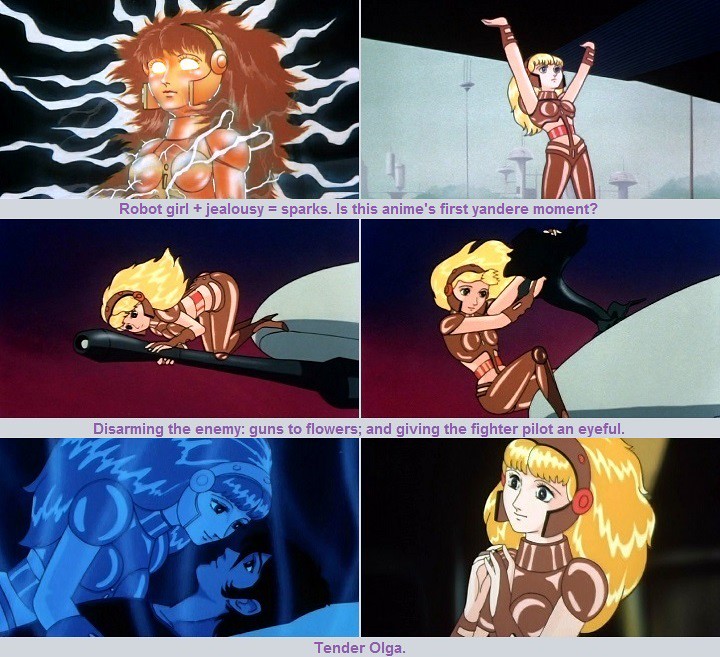
The catch, of course, is, being a robot, Olga is infertile. And, don't forget, in this world children are created artificially in test tubes. Things are complicated further when you consider that Olga is contrasted with Godoh's initial love-interest Lena via yet another Tezuka trope - genuine versus superficial love. And, to the mix you can add a riff on the Pinocchio story - Olga's wish to become human so she can truly love Godoh. She's quite the loaded character thematically and yet the riffs and variations keep piling up. Olga is herself an embodiment of the firebird concept, hence her flaming, shimmering hair. She will burn and rise from the ashes, first as a proxy for the phoenix and, ultimately, with her wish granted. More voluptuous than ever, her first action will be to suckle the child she has been gifted. I find it hard not to like Olga: she's loyal to a fault, extremely capable, heroic and yet comic. The cover of the Madman edition has Godoh with his arm around her protectively as he shoots at some unseen threat. Truth is, the film almost always has it the other way around. He's no slouch, but she repeatedly saves him. I think she's considerably more interesting than two of her more famous predecessors, Honey Kisaragi (Cutie Honey) or, in her pre-1980s versions at least, Françoise Arnoul (Cyborg 009). Rating: good. Thematically fascinating, yet visually and narratively uneven, Space Firebird 2772 has largely been forgotten in the anglophone world. Madman's now out of print 2006 release is the only English language DVD version since the VHS days (and apparently with more accurate subtitling). If you can get over how dated it can look then you may find it a rewarding film. Resources: Space Firebird 2772, Madman ANN The font of all knowledge Anna Panina's 2772 Otaku website The Tesuka Osamu official webiste 100 Anime, Philip Brophy, British Film Institute Publishing The Anime Encyclopaedia, Jonathon Clements and Helen McCarthy, Stone Bridge Press via Kindle 500 Essential Anime Movies: the Ultimate Guide, Helen McCarthy, Collins Design 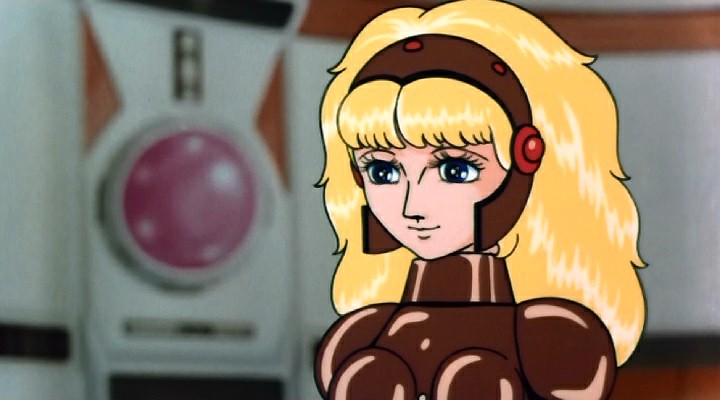
Last edited by Errinundra on Mon Aug 16, 2021 5:10 am; edited 7 times in total |
||||
|
||||
|
Errinundra
Moderator
Posts: 6580 Location: Melbourne, Oz |
|
|||
|
Splash of Crimson #14: Kasha Imhof et al
Space Runaway Ideon (Densetsu Kyojin Ideon) 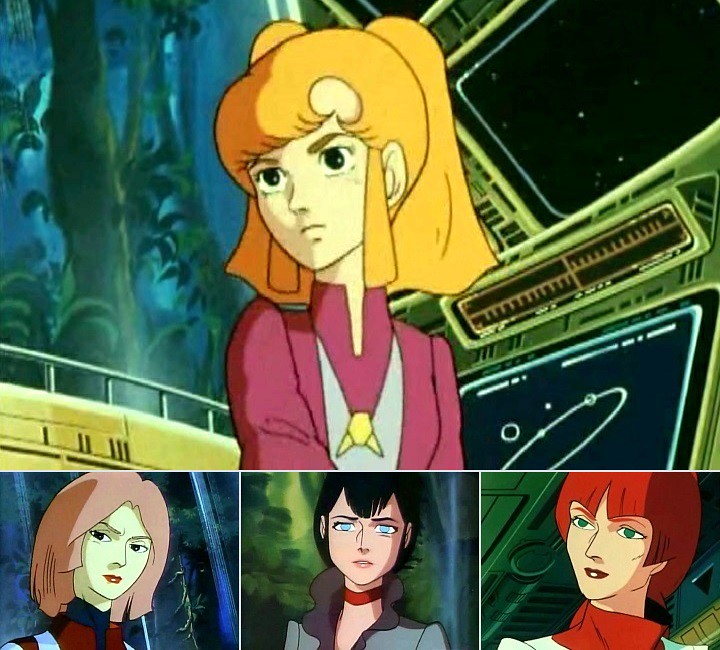
Top: the fiery Kasha in a reflective moment; Bottom from left: linguist Sheryl Formosa; Buff Clan sisters Karala & Harulu Ajiba WARNING: SPOILERS, although I suspect everyone already knows what happens. Synopsis: Far into the future, Earth is colonising planets across the universe. On the sparsely populated, distant planet of Logo Dau, scientists discover buried artefacts - three giant, wheeled vehicles and a spaceship constructed by unknown, extinct predecessors. Linguist Sheryl Formosa, after examining texts left behind, names the builders as the Sixth Civilisation and the ship as the Solo. The colonists are unable to operate the vehicles until they are attacked by similarly previously unknown alien invaders, the Buff Clan, whereupon the three vehicles spontaneoulsy start up and combine to create a giant, pilotable robot that the texts refer to as Ideon. Flown by the hot-headed youngsters Kasha Imhof and Cosmo Yuki, along with the junior military officer Bes Jordan, they manage to hold off the Buff Clan, but not before much of the population of Logo Dau is killed. Thus begins a cat and mouse game across the universe as the refugees are pursued by the Buff Clan, who believe the Ideon is linked to the legendary infinite energy source, the Ide. As the Buff Clan bring to bear more and more forces against the humans, the Ideon becomes ever more powerful, seemingly feeding off the fears of its possessors, to the point of smashing entire planets. Even the earth, in its lust for the power of the Ideon, turns against the runaways. As events escalate, Sheryl, Bes, his Buff Clan lover Karala and the other refugees wonder if the Ideon is orchestrating events to achieve some ineffable purpose of its own, or if the fighting itself is feeding the giant robot. Doba Ajiba, supreme commander of the Buff Clan forces (and father to Karala) and unable to capture the Ideon, refuses to negotiate peace, even when his now pregnant daughter intervenes personally. This ultimate failure invokes the Ideon, which detonates. Everyone dies. Karala's and Bes's child is seen ascending to a higher existence. Production details: Premiere: 08 May 1980 (between Beautiful Fighting Girl #27, Lalabel Tachibana, and Beautiful Fighing Girl #28, Chie Takamoto) Director: Yoshiyuki Tomino (Kaitei Shonen Marine, Uni no Triton, The Star of the Seine, Reideen the Brave, Muteki Chōjin Zambot 3, Muteki Kōjin Daitarn 3 and creator of Mobile Suit Gundam) Studio: Sunrise Original creator: Yoshiyuki Tomino and Sunrise (under their pseudonym Hajime Yatate) Scirpt: Kenichi Matsuzaki, Sukehiro Tomita, Yuuji Watanabe and Hiroyasu Yamaura Music: Koichi Sugiyama Character Design: Tomonori Kogawa Art Director: Mitsuki Nakamura Mecha design: Submarine 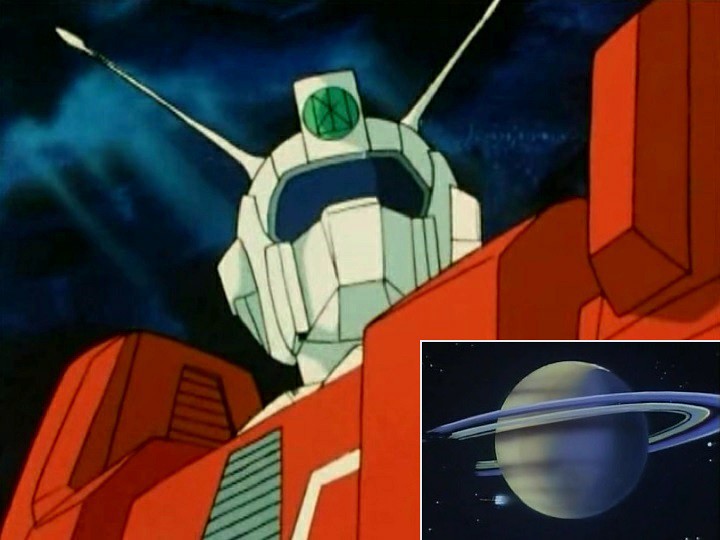
The Ideon. Inset: what it did to the rings of Saturn. Comments: The 1980 world was dominated by the Cold War between the USSR and the USA. In 1978 a coup had installed a communist government in Afghanistan. Violent resistance to the new administration inevitably led to the Soviet Union being dragged into the war the following year. 1979 also saw the overthrow of the corrupt US-backed Somoza government in the Sandanista Revolution in Nicaragua. Both conflicts resulted in classic proxy wars between the two superpowers. Such wars allowed America and the Soviets to chip away at each other without the risk of a nuclear conflagration. On the positive side the SALT II treaty, which sought to reduce the stockpile of nuclear weapons, was signed by the leaders of both nations. Space Runaway Ideon is informed by this political background. On one level it can be seen as a narrative of two military powers - the Buff Clan and Earth - in a competition for supremacy via a super weapon - the Ideon. It might also be considered as a satire of the times in that the two powers' ambitions lead to an ever increasiging destructive power available to them and ultimately to their own demise. The names of some of the characters hint at the allegorical nature of the anime: Formosa (China v Taiwan); Jordan (the Middle East) and Tonkin (the Vietnam War). Such an interpretation isn't essential to the anime, which can be appreciated on a more straightforward level. With Space Runaway Ideon and his earlier Mobile Suit Gundam Yoshiyuki Tomino brings the thematic and narrative complexity found in the likes of The Rose of Versailles and Space Battleship Yamato to the giant robot shows of Go Nagai. I don't want to overstate that, though. Much of the series follows the pattern of introducing a new, more senior Buff Clan military commander with a new stategy or with new, improved weaponry and who attacks the runaways, only to be foiled by the increasing violence meted out by the Ideon. Things are still aeons ahead of the the Go Nagai shows, largely thanks to the much larger, more interesting cast, to the growing oppression of their circumstances and, above all, its targetting of an older audience. On that point SRI tries to be all things to all people. While Cosmo Yuki is supposedly the protagonist, the series could be better seen as an ensemble piece with, I imagine the creators hoping, someone to appeal to each demographic. There's a young male hero (Cosmo), a feisty heroine (Kasha), older, more thoughtful male characters (Bes and Gije Zaral), older, accomplished women (Sheryl and Karala), younger sweet, domestic women (Lin Formosa, Lotta Banda and Rapoh Famu), cute children (Ashura Novak) and even a mascot character (Rapappa the blue squirrel, who gets his own space suit). The creators' hopes remain unfulfilled. While the complexity and the range of characters appeals to my head, the lack of a focus meant that I didn't commit emotionally to any of them - none appealed to my heart. SRI is a dry show. On the whole, they're a dour bunch, another negative. If I had to choose a favourite, she would be Karala, who choses principle over allegiance and love over safety. 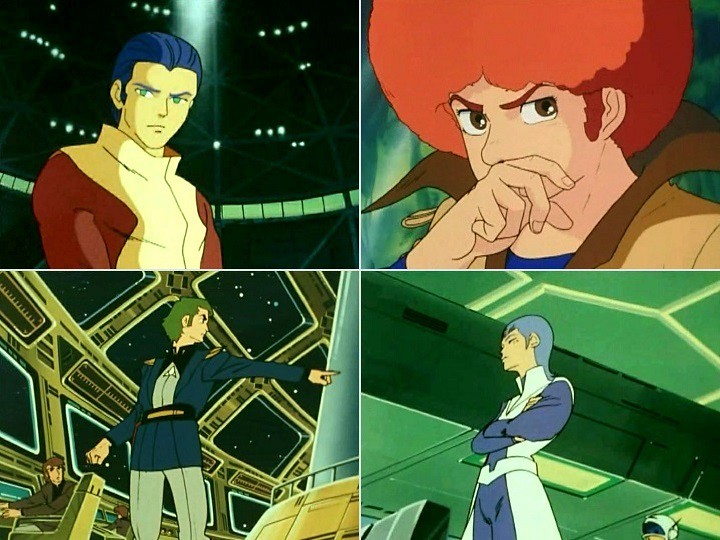
Clockwise from top left: Gije Zaral, who progresses from ambitious Buff Clan warrior to supporter of the runaways; Cosmo Yuki has anime's best afro until Michiko and Hatchin's Atsuko Jackson outdoes him; If posture counts for anything, the Buff Clan's Rukuku Kil is the coolest character; and Bes is the commander of the Solo ship for want of a more senior officer. The series is hamstrung by its famously abbreviated ending. As with the previous year's Gundam, supposedly unsatisfactory ratings had the television network pull the show early, forcing Tomino to prematurely impose his violent climax. Until that point, while the oppressive mood had been ratchetted up relentlessly, the narrative hadn't yet reached an emotional climax. Think of the moment in Puella Magi Madoka Magica where Homura, with her leg smashed under a piece of masonry, finally admits to herself that her quest is hopeless. SRI doesn't get to that cliff-edge before its unconventional resolution is unleased upon the viewer. It's a shame and Tomino can't be blamed. I'm tempted to recommend watching the series as far as the penultimate episode followed by the second of the movies, though, if I recall, the movies make changes to the plot. (I'll be reviewing the movies in due course.) Even more notorious than the abbreviated ending is the extermination of every last character. In the TV series, and again thanks to the premature ending, the slaughter is perfunctory. The intergalactic destruction and infamous deaths you may have seen in gifs or on YouTube are taken, for the most part, from Ideon: Be Invoked. The franchise and director Tomino will, in time, become namers for TV Tropes "Kill 'em All" trope. In that sense, history has been kinder than the TV network to the franchise, however the lack of truly memorable characters, along with the clunky design of the Ideon itself, (compounded by the bad guys having all the cool mecha), meant that Ideon never enjoyed a revival anywhere near Gundam's. I guess there never was much scope for Ideopla. Visually, the series is uneven. The Ideon itself and its components are boxy and ungainly. The three trucks, for want of a better description, serve no purpose whatsoever, so why bother? Transformed as fighter rockets / jets they make more sense, but are ineffectual compared with the giant robot so, again, what's the point? By contrast the Buff Clan mecha are fluid and dynamic in both their design and their motion. The character designs are progressive for their time, something that is noticeable after Space Firebird 2772, though some of the Buff Clan characters - seemingly inspired by Star Trek's Vulcans - go alarmingly off-model in the second half of the series. The battle scenes are a vast improvement over the Go Nagai robot shows, though, occasionally, I struggled to follow what was happening. The music adds mightily to the tension, with its psychedelic electric guitar effects, driving electric base and percussive acoustic string sounds. 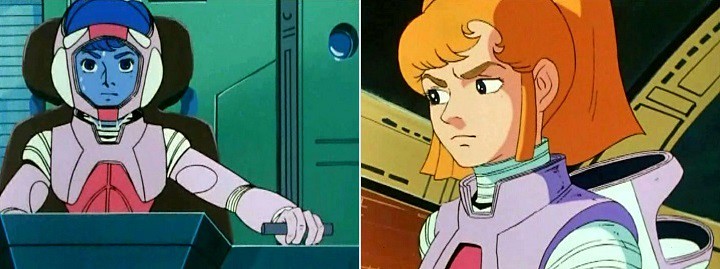
The ever-petulant Kasha Imhof. Kasha Imhof: Though she's comprehensively overshadowed by Sheryl Formosa and Karala Ajiba in their eventual importance to the narrative, I'm starting with Kasha as she is the only human female who participates directly in battle. (I'll deal with Sheyl and Karala when I review the Ideon movies.) There are, it must be said, multiple Buff Clan female warriors, though, thanks to their narrative limitations, they are perhaps less interesting. It seems that good human girls don't fight. Or to put it the other way around, Kasha excepted, fighting women are alien or unnatural. It follows, therefore, that Kasha is neiher good nor natural. As if to emphasise the point most all of Kasha's peers are restricted to nursing in both the domestic and medical meanings of the word. I don't want to be too critical of Tomino: Kasha, Sheryl, Karala and Harulu are all strong, interesting characters. He shouldn't be accused of tokenism. This beautiful fighting girl project has shown me that such an array of strong women was, at the time, rare in anime aimed mostly at a male audience. Kasha is head-strong, easily irritated and, in battle, a psychopath. Think of her as an unfunny precursor of Momo Kawashima from Girls und Panzer. She also lacks Momo's deadpan expression. When everyone else recommends caution, she rushes in for the kill, often putting her comrades in danger. In fairness, everyone in the franchise is trapped in a fight or flight behaviour pattern. That's a message of the franchise: that our aggressive tendencies will be our destruction. Despite being a love interest for Cosmo and, with him, one of the three pilots of Ideon, she's all tsun-tsun and no dere-dere. In the interludes between battle she's assertive in her opinions. She's not the only dry character, though; it's a shortcoming of the franchise. Again, perhaps there's a suggestion of gender typecasting: that empowered women are unappealing. Despite that, I came to like Kasha. The runaways are a sort of rumbunctious family where, as a member, you take for granted people's weakness and strengths but love them anyway. Maybe I just became acclimated to them. Rating: good. After a slow start, Space Runaway Ideon relentlessly ramps up the tension and the violence, culminating in its infamous annihilation of everybody and anybody. It thoroughly warrants a visit from anyone interested in the artform. The catch is, 39 episodes is a big investment for a franchise that, while more than just of curiosity value, has its limitations, including its sudden conclusion, dry characters and, for a time, repetitive episode structures. Resources: Unfortunately, the survey reached the franchise before Maiden Japan's upcoming Bluray release. I've had to rely on fansubs for the review. ANN (I recommend reading Mike Toole's Terminal Tominosis article.) Ideon at Counter-X The font of all knowledge The Anime Encyclopaedia, Jonathon Clements and Helen McCarthy, Stone Bridge Press via Kindle 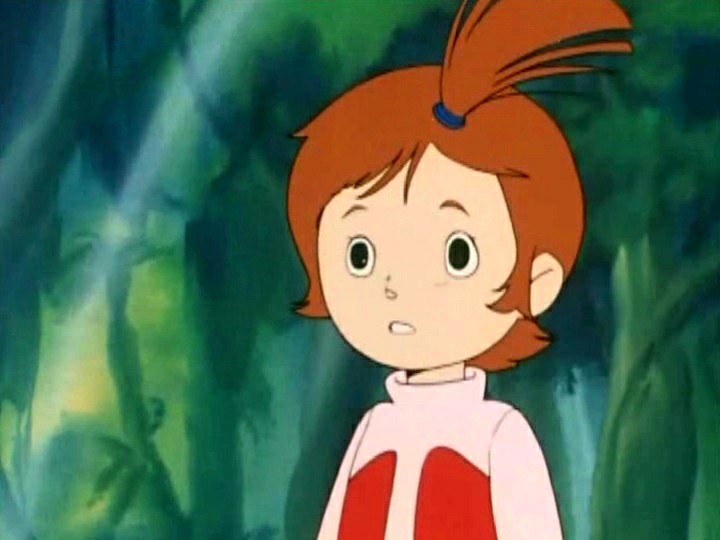
Though you may not recognise her, Ashura Novak is probably the most famous character of the franchise. But let's not get ahead of ourselves. All will be revealed when I review the movies. Last edited by Errinundra on Mon Aug 16, 2021 5:11 am; edited 5 times in total |
||||
|
||||
|
Beltane70
Posts: 3969 |
|
|||
|
This is easily my favorite Tomino series, so I am very familiar with Ashura and why she’s famous!
|
||||
|
||||
|
Errinundra
Moderator
Posts: 6580 Location: Melbourne, Oz |
|
|||
|
I was very much looking forward to watching Space Runaway Ideon, having watched the movies just over seven years ago. Back then, while I liked Be Invoked, I found A Contact almost incomprehensible. That's what you get when you compress 39 episodes into a 1½ hour movie. This time around getting to know the characters properly and having the themes laid out in a leisurely manner helped enormously in my appreciation of what Tomino sets out to achieve in the franchise. In short, it met my expectations.
One of the consequences of the grand survey is that some of the anime I'm watching wouldn't ordinarily appeal to me. A perfect example were the Go Nagai giant robot series. My fears were realised - they were a chore to watch, although fun to review. Perhaps I ought to have replaced two of the three with Reideen the Brave and Zambot 3. Too late now, but I will be covering the Gundam Movie Trilogy and Aura Battler Dunbine, so Tomino is getting some deserved attention. Happily, some other anime I mightn't have watched have been pleasant surprises, eg Magical Fairy Minky Momo or Anne of Green Gables, but that often happens whenever one explores beyond one's normal interests. |
||||
|
||||
|
Beltane70
Posts: 3969 |
|
|||
|
I’m very much looking forward to seeing your review of Dunbine! After Ideon, Dunbine is my second favorite Tomino series. Speaking of Zambot 3, I still need to finish watching it since I only watched about a third of it.
|
||||
|
||||
|
Errinundra
Moderator
Posts: 6580 Location: Melbourne, Oz |
|
|||
|
Splash of Crimson #15: Sayla Mass et al
Mobile Suit Gundam Movie Trilogy 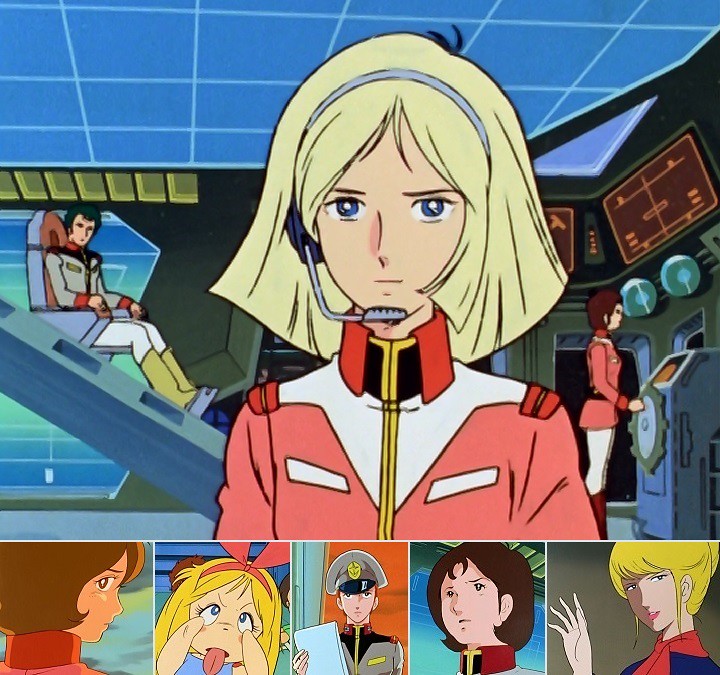
Top: Sayla - intelligence, confidence and strength; characters like her are why this project exists. Bottom (l-r): Comms officer and child-minder Fraw Bow; one of her charges, the endearingly obnoxious Kikka Kitamoto; supply corps officer and guardian angel Matilda Ajan; helm officer Mirai Yashima; Zeon Crowley Hamon Synopsis: Well into the future, wars and overpopulation have led to humans living in gigantic, cylindrical shaped colonies orbiting earth. One such colony, the Principality of Zeon, has declared independence from the Earth Federation and in the ensuing war 50% of the human population has been wiped out. With the Federation developing a new, powerful mobile suit, known as a gundam, Zeon officer Char Aznable makes a sorty to the colony where the mecha is being built. His attack is foiled when Amuro Ray, the son of the suit's chief designer, activates the gundam and fights him off. Thus begins a rivalry that endures for the remainder of the war. Amuro, his friends and surviving military officers escape on a newly built space warship, the White Base, in which they become a decoy attracting the predatory interest of Zeon's finest commanders. Char, when he isn't fighting hand to hand in mobile suits with Amuro, pursues a vendetta against the ruling Zeon family who were behind the murder of his father, an opposition politician. It also turns out that his sister, Sayla Mass, is a crew member on the White Base and an associate of Amuro Ray. Things are further complicated with the appearance of "newtypes" - evolved humans with enhanced intuition and latent psychic abilities. The unleashing of those abilities may determine the outcome of the war. Production details: Premiere: 14 March 1981 (movies 1 & 2) and 13 March 1982 (movie 3); bracketed by Beautiful Fighting Girl #27, Lalabel Tachibana, and Beautiful Fighting Girl #32, Minky Momo Directors: Yoshiyuki Tomino and Ryoji Fujiwara Studio: Sunrise Original creator: Yoshiyuki Tomino and Sunrise (under their pseudonym Hajime Yatate) Script: Hiroyuki Hoshiyama, Kenichi Matsuzaki, Yoshihisa Araki, Yoshiyuki Tomino and Yū Yamamoto Music: Takeo Watanabe, with insert songs by Joe Hisaishi Character Design: Yoshikazu Yasuhiko Art Director: Mitsuki Nakamura Animation Director: Yoshikazu Yasuhiko Mechanical design: Kunio Okawara Comments: An anomalous consequence of reviewing anime in release date order and electing to watch the Gundam movie trilogy rather than the original series is that its younger Tomino / Sunrise sibling Space Runaway Ideon appears earlier in the survey, thus giving the false impression that it (Ideon) was the harbinger of new developments in anime's giant robot and science fiction genres. With that caution behind us, let's get into the fountainhead of one of anime's most enduring brands by starting with the object in the title of the franchise - the gundam, or mobile suit. Clearly derived from the Go Nagai giant robot lineage beginning with Mazinger Z - and I'm sure with heads inspired by the 1970s versions of the cybermen from Doctor Who - the gundams eschew their forebears' monstrous auras. The robots are now simply gigantic weapons. (Ideon will swiftly re-introduce the giant robot as god.) That doesn't make them much less ridiculous. In space the laws of conservation of momentum and, more egegiously, conservation of angular momentum, are pretty much ignored; on land the weight-bearing limitations of surfaces are likewise glossed over. I can forgive those omissions - being too particular would spoil their fluid, precise movements. At the same time, though, by being reduced to weapons, the robots become mere accessories worn or used by the characters. Thematically they become little different from the planes flown by Biggles, the horses and six-shooters of America's western heroes or cars driven by many a protagonist from any culture. They are an extension of the male will to action. The Japanese uniqueness is in their appearance, not their meaning. Throughout the three films they never seemed anything other than decorative embellishments to the more urgent concerns of the narrative and whose more essential purpose is to generate profits through the sales of models. 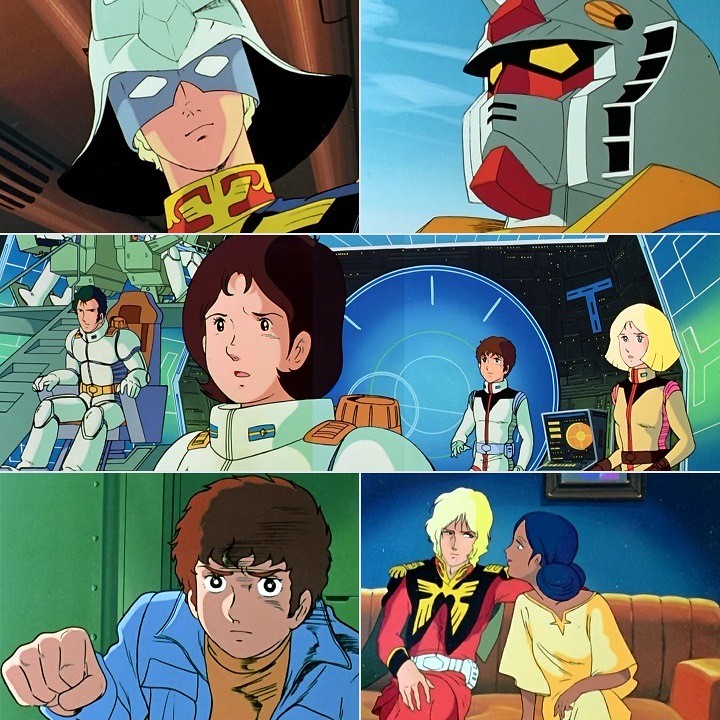
Top: looking purposeful - Char Aznable(left) and gundam. Middle: newtypes sensing a disturbance in the force - (l-r) commander Bright Noa, Mirai, Amuro and Sayla. Bottom: Amuro (left); Char with his lover, the powerful newtype Lalah Sune. Far more interesting, and rewarding, than the hardware, are the convoluted plot, the thematic threads (of which the mobile suits are a part) and the extended range of characters, male and female. Gundam represents the maturing of the otaku sci-fi fandom, from boys watching monster-of-the-week giant robot shows to university students and young, working adults demanding both greater complexity and relatable content. You could describe it as Mazinger Z meets Space Battleship Yamato with both the robots and the space ships multiplied by orders of magnitude. The franchise also illustrates the currents in the fandom already seen with Yamato. Like that series, Gundam wasn't initially successful on TV, with even lower ratings but, also as with Yamato, the advent of the VCR and a fan-based magazine culture meant that fans of the series could not only self-identify and connect with their peers, they could create a sense of historical moment. (This site and thread are, of course, contributing to that process. We are so much more aware of anime today.) Again, like Yamato, by the time the compilation films premiered the fandom had blossomed - 15,000 people turned up on spec to one cinema alone. I don't want to go into the reasons for the franchise's continued popularity - there's plenty of literature about - and, in any case, that's not the focus of this survey. I also won't examine the plot much beyond acknowledging that it's emphatically urgent, dramatic and, well, explosive. The battles are fluid, well-animated and with dynamic perspectives inspired by earlier work by animator Yoshinori Kanada. The compression of events from nearly 18 hours of TV footage to just under 7 hours of film results in occasional jarring or mystifying jumps in the plot despite the linking narration. It isn't a big problem so potential viewers ought not be concerned. In any case the films presumably cherry-pick the most dramatic scenes thereby providing constant activity with little time spent on reflection. Nor do the films dwell long on their many thematic ideas, the most famous of which, after the gundams themselves, is probably the concept of the newtypes, who are either female (Lalah, Sayla and Mirai) or nerds (Amuro and Char) rather than jocks. They are contrasted with the many bellicose, ambitious or musclebound military and political types who litter the series, though some of the female counterparts - Matilda, Hamon and Kycilia to name three - are welcome exceptions. Here, Tomino is acknowledging the otaku fanbase: the newtypes represent the fans; they are the new class of anime viewers. No wonder one of the fan magazines named itself after them. This mutual reinforcement will become a feature of the anime industry. The most interesting development in the franchise lies in the extended cast, particularly in the range and cailbre of the female characters. (The military metaphors are appropriate and deliberate.) Yes, the protagonist - Amuro - along with the antagonist and best character - the somewhat feminine Char - are both male while the regular cannon-fodder soldiers are uniformly male. Nevertheless, females are well represented among the major characters, both in their quantity and quality. Going right back to The Star of the Seine through to Space Runaway Ideon Tomino depicts his women with affection, albeit with their sexuality apparent, quite unlike Go Nagai who treats his female characters with disdain. Not before in anime, has a title aimed squarely at a male audience contained so many females presented so positively. To quote Tamaki Saito,
On that last point, however, I would credit Go Nagai's Sayaki Yumi and Koji Kabuto from Mazinger Z as playing a far more significant role in the development of the trope. 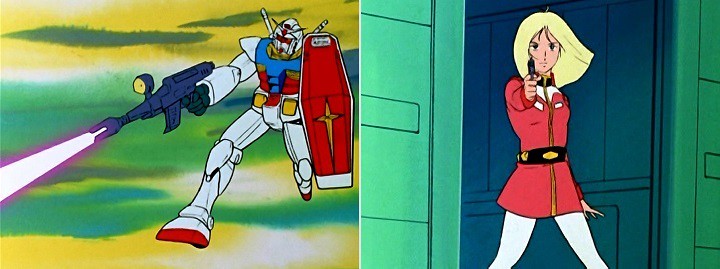
Sayla as gundam pilot and in classic pose as girl with a gun. Sayla Mass aka Artesia Som Deikun: Sayla is the pre-eminent female character of the series partly because other, perhaps more memorable, females appear intermittantly (Matilda, Lalah and Hamon) while the frequently appearing females are more traditionally feminine in their behaviour (Mirai and Fraw, whose name reflects her maternal outlook), and partly because she is a relatively new type in anime aimed at a male audience: self-assured (although her initial attempts at piloting the gundam are comical), self-motivated and self-centred (in a literal, non-judgemental use of the word). She stamps her authority early on when she gives the cynical Kai Shiden a literal stinging rebuke for his craven behaviour. She slips back into a more traditional narrative role when she plays out her central dilemma - the conflict between her principles and her loyalty to her brother, Char. Kudos to her, though, for putting her principles first. Her growing regard for Amuro is presented in the films as incidental rather than central, and as between newtype equals. That she is a marginal character in the franchise subsequently is disappointing - she's a character I'd have loved to follow. Rating: good. Rollicking action sequences and a large and impressive cast, both male and female, are central to a series that breaks new ground for a newly emerging audience. The mecha aren't my cup of tea, but nor are they a distraction, being but large weapons in a complex story of ambition, revenge and the evolution of the human race. The impact of Mobile Suti Gundam on anime, and the development of the beautiful fighting girl, is undeniable and deserved. Along with the Space Battleship Yamato it ushered in the era of the otaku fandom. Resources: Mobile Suit Gundam Movie Trilogy, Nozomi ANN (recommended reading: Lauren Orsini's The Gundam Plot Coherency Scale) Anime: A History, Jonathon Clements, Palgrave MacMillan via Kindle The font of all knowledge Beautiful Fighting Girl, Tamaki Saito, trans J Keith Vincent and Dawn Lawson, University of Minnesota Press The Anime Encyclopaedia, Jonathon Clements and Helen McCarthy, Stone Bridge Press via Kindle Anime: A Critical Introduction, Rayna Denison, Bloomsbury Academic Otaku: Japan's Database Animals, Hiroki Azuma, trans Jonathon E Abel and Shion Kono, University of Minnesota Press The Gundam Wiki Last edited by Errinundra on Mon Aug 16, 2021 5:13 am; edited 3 times in total |
||||
|
||||
|
Errinundra
Moderator
Posts: 6580 Location: Melbourne, Oz |
|
|||
|
It has been a while since I posted a mid-week review. I saw this last Saturday followed by I Want to Eat Your Pancreas the following night. Both films were Australian premieres and both were part of the Madfest anime convention - appropriately at the Melbourne Convention Centre on the south bank of the Yarra River. Cosplayers were present in numbers making for a great atmosphere.
Penguin Highway 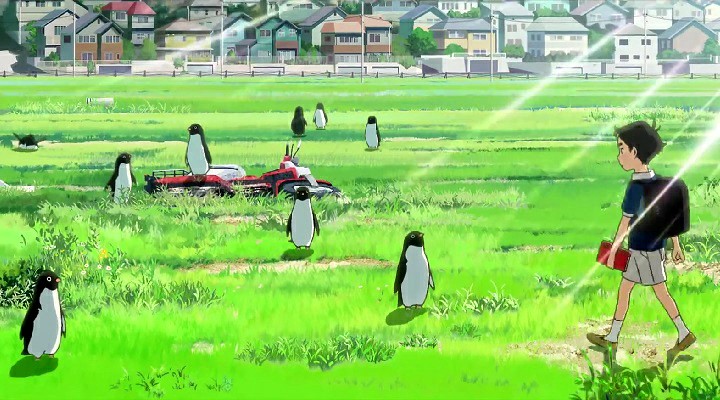
Synopsis: Aoyama is a hyper-intelligent boy who keeps a notepad where he records his observations of the world, along with events and people around him in order to make hypotheses about their underlying motivations or causes. He builds theories then collects data to test them. He also has a crush on the local dental nurse (who isn't ever named). When penguins start appearing - seemingly randomly - around the town Aoyama's interest is piqued, to put it mildly. His investigations lead him to the young woman who becomes ever more magical and mysterious in his eyes. With the help of his best friend Uchida and Hamamoto, his only intellectual equal at school, they discover a shimmering sphere of liquid-like material. All their tests and observations suggest a connection between the woman, the penguins, the sphere and the even more alarming appearance of jabberwockies. When Hamamoto's father is swallowed by the sphere the need to figure out the underlying cause becomes urgent. Production details: Premiere: 29 July 2018 Director: Hiroyasu Ishida Studio: Colorido Source material: the novel ペンギン・ハイウェイ (Pengin Haiwei) by Tomihiko Morimi (The Eccentric Family, The Tatami Galaxy and The Night is Young, Walk on Girl) Script: Makoto Ueda Music: Umitaro Abe Character Design: Yojiro Arai Note: As usual with cinema releases, please treat this as an impression, rather than a review. The images are taken from the trailer. 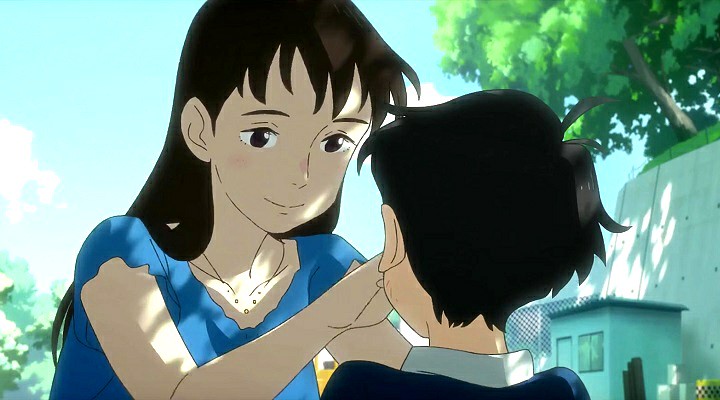
The unnamed woman attaches a thread to Aoyama's loose tooth. The outcome is amusing... and involves a penguin. Comments: As part of the screening we saw a short film of the director greeting his Australian audience and replying to a number of set questions - the sort of thing you often get as an extra on a home release. To a question on influences and inspiration for Penguin Highway, he gave a lengthy credit to Satoshi Kon, the director of Paprika and Paranoia Agent among other things. I mention this, as like the two Kon Films, Penguin Highway is unafraid to break down reality. Animation is the perfect vehicle to destabilise our expectations and so, also like Kon, Ishida has the courage of his convictions: the impossible is taken as given. This allows the director, again like his inspiration, to examine logic and the creative process itself. So where Kon has someone diving into a television screen and emerging from a camera lens, Ishida has someone throw a soft drink can into the air whereupon it transforms into a penguin. Where he differs is that, like almost all new movie releases I've seen from 2016 to 2018 that aren't based on a pre-existing TV series, Ishida's effort is, at its core, fundamentally sweet. (Think Mirai, Maquia, Mary and the Witches Flower, Napping Princess, In this Corner of the World, A Silent Voice and Your Name v Genocidal Organ. Sure, In this Corner of the World ends bitterly, but, for most of the film, the tone is sentimental. Anime has moved a long, long way from where it was in the 1990s. I'm not saying either era is better, just very different.) There's none of the lurking terror that invigorates the two Kon titles. Based on a novel from the author of The Tatami Galaxy it shouldn't surprise that the film has an underlying cerebral theme. The film explores the scientific method, inductive reasoning and the Eureka effect. Mind you, not only does it lack the manic style of Masaaki's Yuasa's anime version of The Tatami Galaxy, but it also avoids the older film's exhortation to its unnamed protagonist to stop rationalising and start living and loving. Aoyama's methodical approach to his astonishing world isn't satirised. Rather he will learn that some things will remain a mystery - such as why the sight of the woman's breasts enchants him or, more importantly, what sort of magical being she might be. This may seem rather dry and to an extent it is, but the solid scientific message is leavened by the woman, the penguins, the strange events we witness and the character of Aoyama himself. I've never seen anything quite like him in anime. The film begins with Aoyama explaining to the audience how clever he is and how splendid are his achievements even this early in his life. He can't wait to become an adult because his genius will manifest itself for the benefit of all humankind. And, what's more, his self-assessment, on the evidence provided, is justified. Thanks to the comical, witty presentation this conceit isn't the least bit annoying. It's not just the humour - Aoyama's unselfconscious, irrepressible self-belief is beguiling. For example, getting back to the woman's breasts, while she can discombobulate him face to face, he's not the least self-conscious as he notes their form and ponders their effect on him. In many ways he is the ideal amateur scientist. You could also see the film as depicting Aoyama's rite of passage from childhood to adolescence, though it doesn't hammer the point. 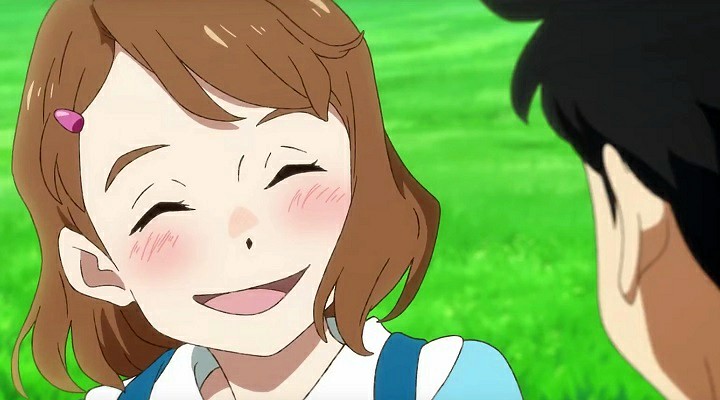
Hamamoto The other characters are variable, some more nuanced than others. The woman is impossibly perfect - and magical - in the young boy's eyes, but also ambiguous. She has her own demons and they just might end up terrifying more than just her nightly dreams. Aoyama's best friend Uchida is such a dill I'm not sure how they came to be friends. Better by far is the unassuming Hamamoto, who is every bit as formidable intellectually as the protagonist, making her a welcome foil. To his chagrin she always beats him at chess. There's Suzuki, a regulation bully with his regulation henchman who tries to make life hell for everyone - the drink vending machine scene is hilariously awful - but finds himself unable to quench Aoyama's self-belief. Special mention must be given to the two amazing scientist fathers: Aoyama's is a physicist; Hamamoto's is a meteorologist. It becomes apparent that the protagonist worships his father, who in an almost godlike way guides the boy in how to find an insight into what's happening. Studio Colorido does a great job visually. While the character designs are anime regulation flat, the backgrounds are enchantingly bright with sun-drenched pastel colours dominating. This makes the darker scenes, such as the forest, all the more ominous. 3D effects aren't always as good. At the climax, Aoyama and the woman are taken on a flight on the backs of penguins, and while the first person perspective movement is exhilarating, the floating, upended buildings look awkward rather than the surreal I'm sure they were meant to be. The penguins are, as you would rightfully expect in an anime, cute, quaint and comical. The film plays on our uncritical regard for them by roughing them up from time to time, which naturally enough increases our sympathy even further. The orchestral soundtrack adds nicely to the atmosphere, while the insert song, sung by Hikaru Utada, has already been added to my mp3 collection. Her slow, extended wailing of the chorus - basically just the song's title Good Night - as the band crescendos behind her is sublime. Problem is, the film is way too long. Each scene is wrung out for all its worth as if Ishida found every little bit too precious to discard. It needed half an hour taken out somehow, somewhere. The characters, the story, the penguins and the visuals aren't enough to carry the film for 119 minutes. The penguins may make the science themes more digestible but they also trivialise them. I would rather Masaaki Yuasa's boisterous, menacing anarchy in The Tatami Galaxy to Isida's cute magic here in Penguin Highway. Given that this is Ishida's and Colorido's first full-length feature film so I shouldn't be too critical, but my interest flagged in the last third. Rating: good, The debut feature film from Hiroyasu Ishida presents us with a magical tale about the scientific method as interpreted by a unique young boy finding himself in the midst of bizarre circumstances. He will learn that sometimes events and people simply defy logical explanation. Were it little shorter and not quite so sweet, it may have warranted a higher score. Resources: ANN The font of all knowledge MyAnimeList Last edited by Errinundra on Thu Feb 13, 2020 7:09 am; edited 1 time in total |
||||
|
||||
|
Errinundra
Moderator
Posts: 6580 Location: Melbourne, Oz |
|
|||
|
I Want to Eat Your Pancreas
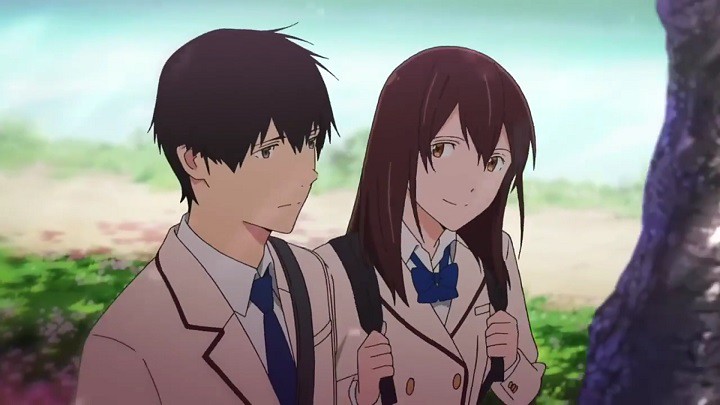
Spring is for blossoms and sad love stories. The young man and Sakura. Notes: 1. The film begins with Sakura's funeral. Discussing her death isn't a spoiler. 2. I'm following ANN's practice in its encyclopaedia and in Kim Morrissy's review of not naming the male protagonist. The film withholds it from the viewer until near the end, even though we see him tell Sakura - to her astonishment - somewhat earlier. It's a play on worlds and a minor plot point. 3. The title refers to a folk belief that a person with a diseased organ will be cured if they eat a portion of the same organ from a healthy person. The expression is another plot device. 4. If you're watching this at a cinema, stay until after the credits finish: there's a short, sweet coda. 5. Images are from the trailer. 6. As ever with my screening reports, this is more an impression than a review. Synopsis: A young man visiting a hospital finds a dropped diary, with the handwritten title Living with Dying. It belongs to a popular and outgoing classmate Sakura Yamauchi, who is dying from a pancreatic disease, something she has kept secret from everyone at their school. The young man is a loner, refuses to form opinions about other people, and is genuinely uninterested in what other people think of him. Sakura, returning for the diary, is intrigued by the young man's reaction to it, so inveigles him into becoming her companion for the time she has left to her. She is extroverted, defining herself by her relationships with others; he is an introvert defining himself by his principles. They will each come to understand the best qualities of the other's personality type and how complementary their worldviews can be. Production details: Premiere: 01 September 2018 Director / script: Shinichiro Ushijima Studio: VOLN (Visit Old Learn New) Source material: the novel Kimi no Suizō o Tabetai (Let Me Eat Your Pancreas) by Yoru Sumino Music: Hiroko Sebu Character Design: Yūichi Oka Art Director: Yukako Ogawa Chief Animation Director: Yūichi Oka 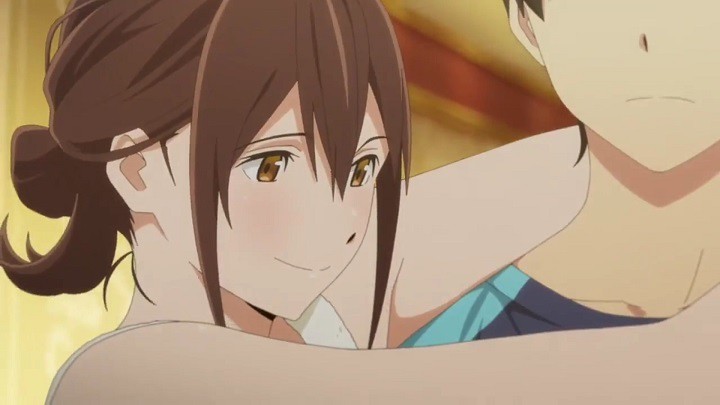
Sakura is carried to bed. Comments: The day after watching Penguin Highway I returned to the Melbourne Convention Centre for the last event of the Madfest Anime Convention. A bigger and correspondingly more emotional crowd of just over a thousand - as announced by the MC - were on hand to get their fill of delicious grief. So, yes, by the end of the film there was plenty of eye-wiping and sniffling all around. If doomed love affairs are your thing then I Want to Eat Your Pancreas comes highly recommended. If not there's still much to admire about it. I may sound cynical, but I'm definitely going to buy it when it gets a release for home viewing. I sincerely hope that I WANT TO EAT YOUR PANCREAS is in big, prominent letters on the spine of the DVD/BD so it leaps out at any casual viewer of my shelves. I don't think I've ever brought up an anime title in conversation at work as much as I did on Friday and Monday. I certainly caught people's attention. Mind you, I think I confirmed their opinions of me. Seriously though, with its clever script and verbal gameplaying I Want to Eat Your Pancreas is worth watching. More than that though, the two leads not only play off each other well with their probing and sparring, they neatly capture, in their personalities, the underlying themes of the movie, in particular the definition of self in a broader community. The question is raised frequently, and often productively, in anime. In our neo-liberal, anglophone world the individual is idealised as surpreme, but the Japanese seem somewhat more ambivalent. Let's start with the protagonist, who represents one end of the spectrum. He has chosen to create himself in his own image, without reference to anyone else. This necessarily entails shutting out judgements from anyone else, which in turn means that he doesn't socialise with his family or the other students at school. He is of the belief that he is seen as boring, which suits him to a tee - people will leave him alone. That two girls in his class are intrigued by him - Sakura (secretly) and her best friend Kyouko - ensures that things will come to a head sooner or later. His behaviour doesn't entirely ring true. My experiences and observations tell me that self-isolating people have either experienced trauma - which may not be apparent to even the closest people to them - or have some psychological trait such as autism. Neither are indicated in the film so, while he's an interesting anime creation who is portrayed consistently and coherently, his personality seems to be created primarily for dramatic and thematic purposes. The viewer may well find him unappealing, as I did initially, but he is idealistic and, when it comes to the test, he has the capacity to care. Sakura is his antithesis. Where he is still, she is constant motion; he lives in his mind, she in her body; he is detached, she connected; and where he initially comes across as conceited, she seems foolish. Neither of the latter points are true - one of the pleasures of the script is in the way we get to know the real, complex characters beyond their facades. Sakura is emotionally intelligent. Her diary's spot-on prediction on the protagonist's reaction to her funeral proves how incisive she can be. To a popular young woman who has always valued how other people view her, one of the horrors of her predicament is that once people - including her parents - learn the terminal nature of her condition they treat her as on object of pity thus inadvertently ignoring the real person. There's the rub. Sakura, having always defined herself through other people, has now become something that appals her. The film beautifully, if bitterly, portrays this dilemma. In the diary discovery scene at the hospital, the protagonist's complete disinclination to treat her illness as exceptional rightfully astonishes her. It's that magical moment in life where one person choses another. Her aim thereafter is to understand him, to get under his skin. Much of the film's humour is in the depiction of this process. The highlight (and this alone, even without the film's title, would have me owning a copy in due course) is a hotel scene where Sakura sets out to get him into bed with her via a game of truth and dare. The scene is clever, funny, a tease - as it should be - and innocently sweet. Don't worry, I won't spoil the outcome, but it is entirely appropriate. 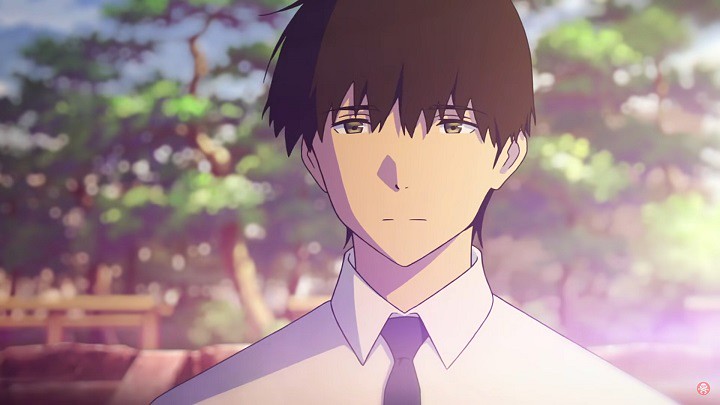
Sakura will learn strength from the protagonist. He will discover, and grief will bludgeon home, that other people are intrinsic parts of himself. While this is all very well and argued convincingly, at a crucial moment the film does a complete cop-out. Besotted with the sentimental Japanese notions of beauty - think spring and blossoms - it conveniently ignores the pain and ugliness of disease. One simply cannot have wasted, incontinent bodies in a teenage love story. The solution is so left-field, so contrived and so gauche that, for me, it ruined the crescendo of emotion that had been so thoroughly constructed to this point. I couldn't cry at the end. It was such a let down. Going by the tears around me in the convention centre, other people's emotional responses weren't as disrupted as mine, so perhaps I am being too critical. Somewhere after the hotel scene, the film loses its deft touch. Director Shinichiro Ushijima can depict a love affair with finesse, but is more heavy-handed with death. Rating: good. The two eccentric central characters become more appealing as the film progresses, as they grow and as the viewer understands them better. This is helped by a script which, until near the end, is playful and clever. The parallel themes of teenagers developing an understanding of the self, and in the relationship of that self to others are handled with aplomb until the film falters a little towards the end. Resources: ANN The font of all knowledge |
||||
|
||||
|
All times are GMT - 5 Hours |
||
|
|
Powered by phpBB © 2001, 2005 phpBB Group
